- Learn Japanese FAQ
- Japanese Characters
- Basic Lessons
- Intermediate Lessons
- Japanese Numbers
- Japanese Words
- Japanese Phrases
- Speak Japanese
- Write Japanese
- Japanese School Directory
- Japanese Test
- Japanese Resources
- Japanese Dictionary
- Electronic Dictionary
- Learning Software
- Site Search
- Site Policies
- Privacy Policy
- Japanese Writing

Write Japanese Hiragana
Let's practise how to write Japanese hiragana characters in the correct way.
There are only 46 of them. In this section you will get to learn the first 25 characters.
In the diagrams that you are going to see, the first character on the left in each row shows the full hiragana character.
The subsequent columns show you the strokes in the correct order. By following the green line of each stroke, memorize how each character is written.
After a few rounds of practice, learn to write each character without looking at the diagram.
As most hiragana characters are quite simple to write, you should not have any problem writing them after some practices.
You just need to be careful on some characters that look similar.
Write Hiragana in the a-line
The following diagram shows how to write hiragana characters あ (a), い (i), う (u), え (e) and お (o) in the correct order and strokes.
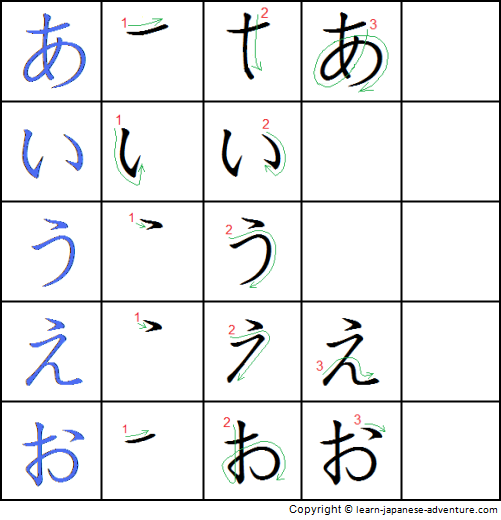
Write Hiragana in the ka-line
The following diagram shows how to write hiragana characters か (ka), き (ki), く (ku), け (ke) and こ (ko) in the correct order and strokes.
Bear in mind that for the character き (ki), the 3rd stroke is not connected to the 4th stroke. However, most software and printed documents still show that the 2 strokes are linked together.
Just be sure that when you are writing, keep the 2 strokes separate. The same goes to the character さ (sa) in sa-line.
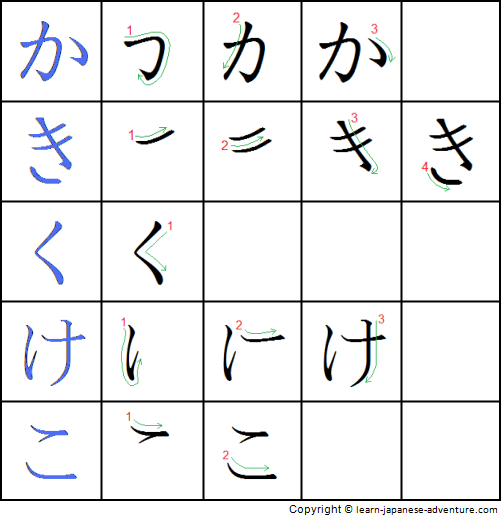
Write Hiragana in the sa-line
The following diagram shows how to write hiragana characters さ (sa), し (shi), す (su), せ (se) and そ (so) in the correct order and strokes.
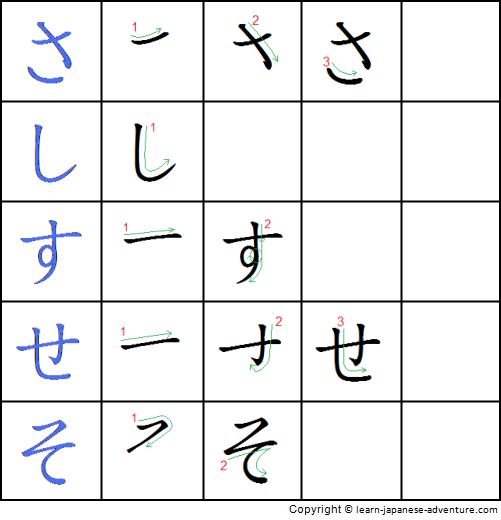
Write Hiragana in the ta-line
The following diagram shows how to write hiragana characters た (ta), ち (chi), つ (tsu), て (te) and と (to) in the correct order and strokes.
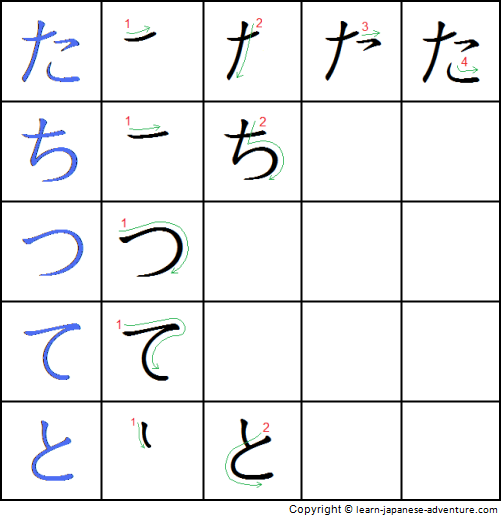
Write Hiragana in the na-line
The following diagram shows how to write hiragana characters な (na), に (ni), ぬ (nu), ね (ne) and の (no) in the correct order and strokes.
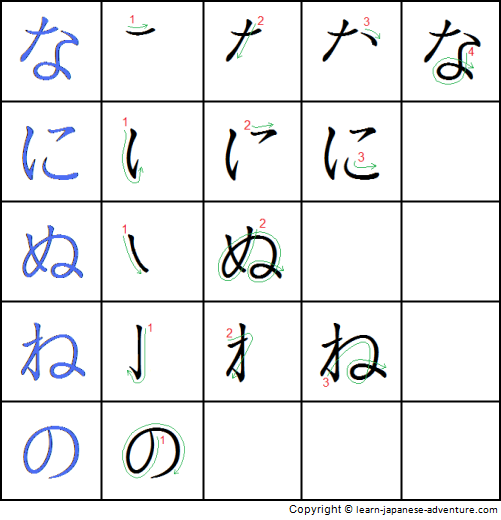
Remember, practice makes perfect. With some hard work, you will soon be able to write hiragana characters without referring to the diagrams.
Do you want to learn more about how to write all the Japanese hiragana and katakana characters? Make sure you check out these video lessons where you will be guided through every single letter .
By the way, this link above is an affiliate link, which means that I would earn a commission if you do end up purchasing the related learning course. It's at no extra cost to you, and please if you have any questions related to this learning course, please let me know and I would be happy to answer them for you.
Related Pages
1. Learn to write hiragana in the ha-line, ma-line, ya-line, ra-line, wa, wo and n .
2. Learn to write katakana in the a-line, ka-line, sa-line, ta-line and na-line .
3. Learn to write katakana in the ha-line, ma-line, ya-line, ra-line, wa, wo and n .
To know more, I recommend you take a look at this book on hiragana .
Like This Page?
Facebook comments.
Would you prefer to share this page with others by linking to it?
- Click on the HTML link code below.
- Copy and paste it, adding a note of your own, into your blog, a Web page, forums, a blog comment, your Facebook account, or anywhere that someone would find this page valuable.
Affiliate Link

Learn Japanese Free at JapanesePod101.com

Home | About Me | Contact Me | Resources | Site Policies
This Website is Powered by SBI!
- Skip to primary navigation
- Skip to main content
- Skip to primary sidebar
Smile Nihongo Academy - Information Site
Japanese learning Information & Blog by Yuko Sensei
Are you a student? Go to School Website Login Here
Learn to Write Hiragana
This entire page is dedicated to helping you learn to write Hiragana accurately. Once you develop bad habits, it is very hard to shake them off. I’ve seen such cases too many times among my students in my teaching career . To prevent you from that, let’s cover three important tips before the first lesson. These rules apply not only to Hiragana but also Katakana and Kanji.
On a side note, good penmanship is highly valued in the culture.
Three Tips When You Learn to Write Hiragana
Tip 1: stroke directions.
Know that there are only two directions when you write each stroke of Japanese letters:
- Left to right, OR
- T op to bottom.
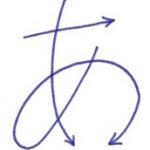
As a result, Japanese people have accustomed to writing letters that way. It, in fact, helps you write letters in a flow and beautifully.
Tip 2: Three Types of Stroke Ending
Each stroke has one of the following endings: Stop (tome), Brush-up (hane) and Release (harai).

Tip 3: Follow Hand-written Versions
Some Hiragana letters look quite different between the handwritten version and printed version as below. Be sure that you master the handwritten version of Hiragana.

The closest font to handwritten Hiragana is Kyokasho-tai (Textbook font) . I use the font in the videos below and all of the Hiragana materials I provide.
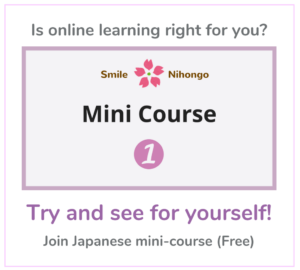
Let’s Learn to Write Hiragana!
Below are Hiragana lessons in the order of the Hiragana chart. There are 46 basic Hiragana letters. Please follow the order below to learn to write Hiragana.
1. Vowels あいうえお & N ん
2. Ka Ki Ku Ke Ko かきくけこ
3. Sa Shi Su Se So さしすせそ
4. Ta Chi Tsu Te To たちつてと
5. Na Ni Nu Ne No なにぬねの
6. Ha Hi Hu He Ho はひふへほ
7. Voiced Sounds – G, Z, D, B & P
8. Ma Mi Mu Me Mo まみむめも
9. Ya Yu Yo やゆよ
10. Ra Ri Ru Re Ro らりるれろ
Happy learning!
ゆうこせんせい Yuko-sensei
Are you a complete beginner?
Start Japanese from zero and learn the basics
Mini-Course for Beginners

The Complete Guide to Learning Hiragana: Reading & Writing (With Video)

ひらがな ( hiragana ) is the fundamental component of the Japanese writing system. カタカナ ( katakana ) and 漢字 ( kanji ) are the other two writing systems in Japanese. If you want to learn all of the hiragana for free with step-by-step videos and descriptions, this guide is for you.
In Japan, people start learning ひらがな ( hiragana ) at a very young age, usually in preschool or early elementary. Mastering hiragana might seem overwhelming; however, this article will teach you everything you need to know about writing, pronunciation, and any valuable tips regarding hiragana .
Modern Hiragana Characters

Modern hiragana has 46 base characters: five singular vowels, 40 consonant-vowel unions, and one singular consonant. Some of you may have seen it before, but the 46 characters are organized in a chart format, which is called あいうえお表 ( aiueo hyō ).
The chart has ten rows of up to five hiragana characters. The upcoming sections are organized according to the chart. In this guide, all hiragana characters will be explained. You’ll learn how to pronounce and write each correctly.
*Note: While there are many methods to memorize the hiragana characters, it’s just as easy (if not easier) to just remember the characters as you practice writing them. The characters are simple and are pretty simple to remember with a little work. If you follow this up by reviewing the characters (flashcards work great for this), you’ll remember all of the characters in no time.
Part I: How to Read and Write Hiragana: 直音 (Chokuon) – Basic Characters
These are all of the basic characters of hiragana . Be sure to practice reading and writing each character to ensure that you master all of them. We’ll be using these basic characters to create more complex hiragana later on.
If you want to use the blank hiragana practice sheets as seen in the video, you can get that here: Blank Hiragana Writing Practice Sheet
あ行 (A Gyō) – A Row: Pronunciation

あ ( a ) is often the first character people learn. As with all characters, try to match of balance and stroke lengths of the examples shown in the video.
This character looks very similar to お ( o ), so pay close attention to the stroke order. It is different than writing お ( o ). Also notice that お ( o ) has a small slash on the right side while あ ( a ) does not.
Words Starting With あ (A)
• あひる ( ahiru ): Duck (animal) • あるく ( aruku ): To walk

い ( i ) looks relatively similar to り ( ri ). い ( i ) has two vertical lines that are similar in length, whereas り ( ri ) has a longer line on the right side.
Words Starting With い (I)
• いす ( isu ): Chair • いか ( ika ): Squid

う ( u ) looks a little bit like the katakana character ラ ( ra ). Be sure to practice writing う ( u ) with a flowing curve instead of the rigid, straight lines that ラ ( ra ) has.
Words Starting With う (U)
• うめ ( ume ): Japanese plum • うに ( uni ): Sea urchin

Some people think that え ( e ) looks like う ( u ) character described above. Just be sure to pay attention to the second stroke and feel how the last stroke (“the tail”) flows off of your pen.
Words Starting With え (E)
• えんぴつ ( enpitsu ): Pencil • えいご ( eigo ): English

お ( o ) does look very similar to the first character we learned, あ ( a ). Many people get these two characters mixed up in the beginning, so be sure to follow the correct stroke order of both characters. お ( o ) has a small slash on the right side for its final stroke. This is also why you need to practice writing the characters; not only will it help you to remember the characters faster, but you’ll notice more details that you may miss if you just practice reading them.
Words Starting With お (O)
• おに ( oni ): Demon • おなか ( onaka ): Stomach

か行 (Ka Gyō) – Ka Row: Pronunciation

When you start to learn katakana , you’ll notice that the カ ( ka ) looks almost identical to this hiragana か ( ka ). The biggest difference is the third stroke in this hiragana character. However, the hiragana か is also more rounded at the upper right-hand corner. Be sure to follow the video to see exactly how it’s written.
Words Starting With か (Ka)
• かさ ( kasa ): Umbrella • からあげ ( karaage ): Deep-fried food, usually chicken

This character also looks similar to its katakana equivalent (キ). So be sure to focus on how this hiragana き ( ki ) is written. The great thing about hiragana and katakana characters looking similar to each other is that it makes it easier to remember both.
However, き ( ki ) also looks similar to the hiragana さ ( sa ). Be aware that き ( ki ) has an extra horizontal line running through it.
Words Starting With き (Ki)
• きつね ( kitsune ): Fox • きけん ( kiken ): Danger

This character is a breath of fresh air since it’s one of the few (if not only) characters that looks familiar. It is similar in shape to the “less than” symbol, just spread out a little wider.
Words Starting With く (Ku)
• くじら ( kujira ): Whale • くらげ ( kurage ): Jellyfish

け ( ke ) is similar to the hiragana character は ( ha ). The difference is at the end of the third and last stroke. The third stroke of け ( ke ) trails off to the left side while は ( ha ) goes back and loops over itself.
Words Starting With け (Ke)
• けしごむ ( keshigomu ): Eraser • けっこん ( kekkon ): Marriage

The computerized version of Japanese writing differs from how it’s written by hand. This character is a good example. The image shown to the left doesn’t have a small “hook” at the end of the first stroke. However, if you were to write こ ( ko ) by hand, you would need to put this small hook at the end in order for it to look nice.
Words Starting With こ (Ko)
• こども ( kodomo ): Child • これ ( kore ): This

さ行 (Sa Gyō) – Sa Row: Pronunciation

As mentioned above in the ka -row section, さ ( sa ) looks a little like き ( ki ). However, さ ( sa ) also looks like the hiragana character ち ( chi ), especially when it’s in computer font form. When writing it out by hand, it’s easy to see that the two characters are quite different. In addition to the third and last stroke of さ ( sa ) going in the opposite direction of ち ( chi ), it is also not touching the first two strokes.
Words Starting With さ (Sa)
• さかな ( sakana ): Fish • さしみ ( sashimi ): Raw, sliced seafood (usually fish)

し ( shi ) looks like a backwards “J” or a fishhook. It is also similar to the first stroke of the character も ( mo ), which we’ll learn a little bit later. While this character is only one stroke, it takes a bit of practice to make it look nice. As with all characters, aim to have a nice balance (of the strokes and spaces in-between and around the strokes) when writing them.
Words Starting With し (Shi)
• しまうま ( shimauma ): Zebra • しお ( shio ): Salt

If you combine す ( su ) with し ( shi ) above, you’ll get the popular Japanese food すし ( sushi ). Have fun with “loop” in the second stroke. This type of loop is unique to certain characters in hiragana . It does not appear in katakana or commonly used kanji .
Words Starting With す (Su)
• すいか ( suika ): Watermelon • すず ( suzu ): Bell

This another character that looks similar to its katakana counterpart. The hiragana せ ( se ) has three strokes while the katakana セ ( se ) only has two. However, it can be easy to get these two characters mixed up in the beginning.
Words Starting With す (Se)
• せみ ( semi ): Cicada • せっけん ( sekken ): Soap

The bottom half of そ ( so ) is slightly similar to て ( te ), but the single stroke and look of そ ( so ) is so unique that most people remember it quickly.
Words Starting With そ (So)
• そら ( sora ): Sky • それ ( sore ): That

た行 (Ta Gyō) – Ta Row: Pronunciation

た ( ta ) and に ( ni ) look a little similar. た has an extra horizontal line on the left side (the first stroke). た ( ta ) also has four strokes while に ( ni ) has three.
Words Starting With た (Ta)
• たぬき ( tanuki ): Raccoon dog • たこ ( tako ): Octopus

As previously mentioned, ち ( chi ) can be mistaken for さ ( sa ) since they look similar. It’s almost like a lower case “b” and “d” where the bottom part of the character determines which letter it is. Another thing to note is that “chi” is the Hepburn romanization style. There is another romanization style called 訓令式 ( kunrei shiki ), where ち would be written as “ ti .” Proper English translations use the Hepburn style, but be aware that there are other ways to write romaji.
Words Starting With ち (Chi)
• ちず ( chizu ): Map • ちじ ( chiji ): Governor

つ ( tsu ) looks like し ( shi ) flipped over and turned on its side. Even though they share the same shape, the difference in their position makes them easy to recognize and remember. Practice them both and you’ll see for yourself 🙂
Words Starting With つ (Tsu)
• つくえ ( tsukue ): Desk • つる ( tsuru ): Crane (bird)

て ( te ) almost looks like curvy “T.” As you learn more Japanese, you’ll find yourself using the て ( te ) character a lot. Not only is it common in words, but there is something called the て-Form . It is a way to conjugate verbs, adjectives, and nouns to create all kind of wonderful grammatical patterns. You’ll use this character so much there’s no way you’ll forget it!
Words Starting With て (Te)
• て ( te ): Hand • てがみ ( tegami ): Letter (as in “I wrote a letter to her…”)

と ( to ) is also another character you’ll be using a lot in your Japanese studies. It is a useful Japanese particle that means “and” or “with.” It is also one of the easier particles in Japanese to understand and use. So practice this one because you’ll be using it often in the future!
Words Starting With と (To)
• とけい ( tokei ): Clock • とかげ ( tokage ): Lizard

な行 (Na Gyō) – Na Row: Pronunciation

な ( na ) can feel a little tricky to write at first. Put the effort into writing this character neatly and smoothly, because you’ll be using it relatively often in your Japanese studies. There are two types of adjectives in Japanese ; い-adjectives and な-adjectives. な-adjectives all end in な, so you’ll be using this character a lot when you learn about adjectives.
Words Starting With な (Na)
• なす ( nasu ): Eggplant • なぞ ( nazo ): Riddle, puzzle

As mentioned previously, に ( ni ) looks a little bit like た ( ta ). You just need to be aware of the first horizontal stroke in た ( ta ) (or the lack thereof in に ( ni )).
Words Starting With に (Ni)
• にわとり ( niwatori ): Chicken • にわ ( niwa ): Garden, yard

ぬ ( nu ) and め ( me ) look almost the same. Many people get these characters mixed up, so be sure to learn this correctly from the beginning. The difference is that ぬ ( nu ) has a small loop at the bottom (that looks like a “2”) while め ( me ) does not.
Words Starting With ぬ (Nu)
• ぬりえ ( nurie ): Picture for coloring (like a coloring book) • ぬの ( nuno ): Cloth

This is another character that looks very similar to another. ね ( ne ) and れ ( re ) are very similar. Just like with ぬ ( nu ) and め ( me ), the difference is whether or not there is a small loop on its final stroke. ね ( ne ) has a small loop at the bottom (that looks like a “2”) while れ ( re ) does not.
Words Starting With ね (Ne)
• ねこ ( neko ): Cat • ねずみ ( nezumi ): Mouse, rat

の ( no ) looks like the letter “e” that has been flipped over and rotated. It is pronounced almost the same way as “no” in English. It is also another useful particle , which is used for the possessive form (my book, his computer, my company’s car, etc.)
Words Starting With の (No)
• のり ( nori ): Seaweed (for eating), glue • のみもの ( nomimono ): Drink(s), beverage

は行 (Ha Gyō) – Ha Row: Pronunciation

は ( ha ) and ほ ( ho ) look very similar. The biggest difference is that ほ ( ho ) has two horizontal lines running through the last vertical stroke on the right side. は ( ha ) only has one horizontal line going through it.
Also, は is actually pronounced “wa” when it’s used as a particle. You’ll learn more about this when you start to study basic Japanese sentences.
Words Starting With は (Ha)
• はさみ ( hasami ): Scissors • はな ( hana ): Flower(s), nose

ひ ( hi ) is only one stroke, so just be sure to start from the left side ending the stroke on the right side.
Words Starting With ひ (Hi)
• ひつじ ( hitsuji ): Sheep • ひみつ ( himitsu ): Secret

ふ ( fu ) looks a little complicated to write. It is probably the most difficult hiragana character to write, but you can still learn to write it quickly with a little practice. There are also two ways to write ふ ( fu ). Check out the video to see both ways you can write this character. Also, you would think this character would be read as “ hu ,” not “ fu .” Actually, both are correct, but as explained in the ち ( chi ) description, fu is the Hepburn romanization style and is used much more commonly in proper English translations.
Words Starting With ふ (Fu)
• ふぶき ( fubuki ): Snowstorm • ふきん ( fukin ): Dishcloth

へ ( he ) is another single stroke character. It is pretty easy to write, but just make sure to start on the left side, stroking down towards the right.
Words Starting With へ (He)
• へび ( hebi ): Snake • へや ( heya ): Room

As mentioned in the description for は ( ha ) above, ほ ( ho ) looks almost the same but has an extra horizontal line at the top. Be sure to be aware of this extra line to differentiate between は ( ha ) and ほ ( ho ).
Words Starting With ほ (Ho)
• ほたて ( hotate ): Scallop • ほほえみ ( hohoemi ): Smile

ま行 (Ma Gyō) – Ma Row: Pronunciation

ま ( ma ) looks like the right side of ほ ( ho ), but there is a very important detail you should be aware of. The vertical line going through the two horizontal lines in ま ( ma ) extends above the top horizontal line. You’ll start writing the vertical line (the third stroke) above the top horizontal line (the first stroke). However, in ほ ( ho ), the vertical line does not extend past the top horizontal stroke. For ほ ( ho ), you’ll start the vertical line (fourth stroke) at or just below (but still touching) the top horizontal stroke.
Words Starting With ま (Ma)
• まくら ( makura ): Pillow • まぐろ ( maguro ): Tuna

み ( mi ) is another character with that unique loop shape on its left side. Have fun writing this character as you go down, loop around, and finish the first stroke on the right-hand side.
Words Starting With み (Mi)
• みず ( mizu ): Water • みち ( michi ): Street, road, path

む ( mu ) has a similar shape as す ( su ), except the line keeps going after the loop and extends to the right, and finishes by curving back up slightly.
Words Starting With む (Mu)
• むし ( mushi ): Insect • むすこ ( musuko ): Son

As mentioned earlier, め ( me ) looks almost exactly like ぬ ( nu ). The differnce is that ぬ ( nu ) has a loop at the end while め ( me ) does not.
Words Starting With め (Me)
• め ( me ): Eye • めがね ( megane ): Eyeglasses

も ( mo ) is similar to し ( shi ), but has two horizontal lines cutting through its vertical stroke.
Words Starting With も (Mo)
• もり ( mori ): Forest • もも ( momo ): Peach

ら行 (Ra Gyō) – Ra Row: Pronunciation

ら ( ra ) has a unique shape and sometimes people confuse it for さ ( sa ) or や (ya). It takes a little bit of getting used to, but if you practice writing all the characters (as much as you can!) and review with flashcards/notes, you’ll remember all of them in no time.
Words Starting With ら (Ra)
• らくだ ( rakuda ): Camel • らくがき ( rakugaki ): Graffiti, scribble

This hiragana り ( ri ) looks almost identical to the katakana リ ( ri ). This makes it easy to remember both, but when writing, the hiragana り ( ri ) usually has a small hook at the end of the first stroke.
Words Starting With り (Ri)
• りんご ( ringo ): Apple • りかい ( rikai ): Understanding

る ( ru ) and ろ ( ro ) look very similar, so just remember that る ( ru ) has a loop at the bottom while ろ ( ro ) does not.
Words Starting With る (Ru)
• るす ( rusu ): Absence • るいじ ( ruiji ): Resemblance, similarity

れ ( re ) looks like ね ( ne ). Just remember that れ ( re ) does not loop around at the end of the second stroke. These differences seem very small at first, but after a while you’ll notice them easily.
Words Starting With れ (Re)
• れきし ( rekishi ): History • れんこん ( renkon ): Lotus root

As previously mentioned, ろ ( ro ) looks like る( ru ). Just remember that ろ ( ro ) does not have a loop at the end of its stroke.
Words Starting With ろ (Ro)
• ろうそく ( rōsoku ): Candle • ろんり ( ronri ): Logic

や行 (Ya Gyō) – Ya Row: Pronunciation

Traditionally, the ya -row comes before the ra -row on hiragana charts. However, there are only three characters in the ya -row, so we decided to teach it after the ra -row to make it easier to follow and hopefully easier to understand.
Words Starting With や (Ya)
• やかん ( yakan ): Kettle • やきにく ( yakiniku ): Yakiniku, Japanese grilled meat done in a Korean barbeque style

ゆ ( yu ) is a fun character to write. It almost looks like a picture of a fish. You’ll also see this character if you go to an onsen ( hot spring ) in Japan. At an onsen in Japan, ゆ ( yu ) means “hot water” or “hot spring water” that you bathe in. The kanji for hot water is 湯 ( yu ), but you will often see the hiragana “ゆ” written on signs or noren (short curtains hung at the top of a door/entrance) at onsens.
Words Starting With ゆ (Yu)
• ゆき ( yuki ): Snow • ゆず ( yuzu ): Yuzu (type of citrus fruit)

よ ( yo ) looks a little bit like ま ( ma ). However, よ ( yo ) only has one horizontal line (the first stroke) while ま ( ma ) has two. Also, if you look closely, the horizontal line in よ ( yo ) does not go through the vertical stroke. Be sure to practicing writing よ ( yo ) so that the first stroke doesn’t cut across the second, vertical stroke.
Words Starting With よ (Yo)
• よる ( yoru ): Night • よやく ( yoyak u): Appointment, reservation, advance order

わ行 (Wa Gyō) – Wa Row: Pronunciation

わ ( wa ) looks similar to ね ( ne ). The difference is ね ( ne ) has a loop and わ ( wa ) doesn’t.
Words Starting With わ (Wa)
• わに ( wani ): Alligator • わくせい ( wakusei ): Planet

This is actually another character for “ o ,” but it is sometimes written as “ wo ” as shown here. Usually, we write this を as “ o ” in our other Japanese lessons , as it is more standardized for learners of Japanese. The biggest difference between を ( o ) and お ( o ), is that this を ( o ) is a particle, and is not used in any words.
Words Starting With を (Wo)
There is no Japanese word that starts with を ( o ). を is a particle and indicates what the direct object of a sentence is.

The last character! After you complete this, you’ll have learned all of the hiragana characters! However, your work is not done yet. There’s a few more things to learn about hiragana before you have completely mastered everything.
Words Starting With ん (N)
There is no Japanese word that starts with ん ( n ). Do you know a Japanese word game called しりとり ( shiritori )? The players need to say a word that begins with the last character of the previous word that was said by the other player. If a player says a word ending in ん ( n ), they lose the game, as no Japanese word begins with that character.

Congratulations!!! You’ve learned all of the basic hiragana characters. Give yourself a big pat on the back! However, there are still things you need to learn. There are a few things that you can add to some of these hiragana characters to change their pronunciation. Also, you can combine certain characters together to make a “hybrid” character!
Part II: Advanced Hiragana: Characters With Different Sounds
If you mastered all of the hiragana characters on this page, the hard work is over. Now we just need to learn a few more things to truly master all of commonly used hiragana characters in Japanese.
濁音 (Dakuon) – Hiragana with 濁点(Dakuten)
濁点 ( Dakuten ) is the two small dashes that you write on the upper right-hand side of certain characters. This mark looks similar to double quotation marks in English (“). This will change the pronunciation of the character from an unvoiced consonant, to a voiced consonant, 濁音 ( dakuon ).
Sounds confusing? Don’t worry! It’s actually really easy. You just need to remember which characters can take this mark, and the rest is really easy.
The only characters that can take the 濁点 ( dakuten ) are the か ( ka ) , さ ( sa ) , た ( ta ) , and は ( ha ) rows . Let’s see what happens when you add 濁点 ( dakuten ) to the characters in these rows.
濁音 (Dakuon): か (Ka) Row Becomes the が (Ga) Row
Any character in the か ( ka ) row that has a dakuten attached to it will go from a “k” sound to a “g” sound.
- か ( ka ) —> が ( ga )
- き ( ki ) —> ぎ ( gi )
- く ( ku ) —> ぐ ( gu )
- け ( ke ) —> げ ( ge )
- こ ( ko ) —> ご ( go )

濁音 (Dakuon): さ (Sa) Row Becomes the ざ (Za) Row
Any character in the さ ( sa ) row that has a 濁点 ( dakuten) attached to it will go from a “s” sound to a “z” sound, EXCEPT for し ( shi ). し ( shi ) will turn into じ ( ji ).*
- さ ( sa ) —> ざ ( za )
- し ( shi ) —> じ ( ji )
- す ( su ) —> ず ( zu )
- せ ( se ) —> ぜ ( ze )
- そ ( so ) —> ぞ ( zo )
*Note: じ ( zi ) is the 訓令式 ( kunrei shiki ) reading, which is the system ordered by the Cabinet of Japan. However, ji is the Hepburn style of romaji, which is what is used in most English translations. It is also much closer to the pronunciation of that actually Japanese. For example, the word “じかん” means “time.” It is pronounced “ ji kan.” If you were to pronounce it using the kunrei shiki romanization, it would be “ zi kan,” which would not be the correct pronunciation.

Example Words: ざ (Za) Row
- ざ ( za ) —> ざ ぶとん ( za buton ): Floor cushion
- じ ( ji ) —> じ かん ( ji kan ): Time
- ず ( zu ) —> ず かん ( zu kan ): Picture book
- ぜ ( ze ) —> ぜ んそく ( ze nsoku ): Asthma
- ぞ ( zo ) —> ぞ う ( zō ): Elephant
濁音 (Dakuon): た (Ta) Row Becomes the だ (Da) Row
The た ( ta ) row is a little tricky. It has two exceptions, but it’s not too difficult. Characters in the た ( ta ) row that has a 濁点 ( dakuten ) attached to it will go from a “t” sound to a “d” sound, EXCEPT for ち ( chi ) and つ ( tsu ).
ち ( chi ) will turn into ぢ ( ji ). Wait a minute! We just learned that し ( shi ) also turns into じ ( ji ). Yes, both of these characters have the same romaji and same pronunciation. How can two different characters have the same reading?
The answer lies in something called 連濁 ( rendaku ) in Japanese. Basically, 連濁 ( rendaku ) is when you combine words together that result in the first consonant of the second word becoming voiced. This is the same thing we are doing here; ち ( chi ) becomes a voiced ぢ ( ji ) with the 濁点 ( dakuten ). Let’s check out an example.
Let’s look at two different words and combine them. はな ( hana ) can mean either flower or nose. For our example, it will mean “nose.” ち ( chi ) also has two meanings; it can either mean blood or ground/earth. In this example, it will mean “blood.”
If we put these words together, it will mean “nosebleed” and it should look like this: はな ち ( hanachi )…BUT
Because of the 連濁 ( rendaku ), the first constant of the second word ち ( chi – blood) will become voiced —> ぢ ( ji ). Therefore, the correct word will be “はな ぢ ( hana ji ).” Most of the time, ぢ ( ji ) is found in the middle or end of words. There are few (if any) words that start with ぢ ( ji ). It’s when the original word uses ち ( chi ) but becomes voiced when combined with other words.
The other exception is つ ( tsu ). With the 濁点 ( dakuten ), it will change to づ ( zu ). This also shares the same romaji as the character す ( su ) —> ず ( zu ). Just like with the ぢ ( ji ) character above, づ ( zu ) is most used as 連濁 ( rendaku ). In other words, づ ( zu ) is mainly used when it is combined with other words (in the middle or end of words, not at the beginning).
Let’s take a look at the whole だ ( da ) row:
- た ( ta ) —> だ ( da )
- ち ( chi ) —> ぢ ( ji )
- つ ( tsu ) —> づ ( zu )
- て ( te ) —> で ( de )
- と ( to ) —> ど ( do )

Example Words: だ (Da) Row
- だ ( da ) —> だ いず ( da izu ): Soy beans
- ぢ ( ji ) —> はな ぢ ( hana ji ): Nosebleed
- づ ( zu ) —> つ づ き ( tsu zu ki ): Continuation (of something; story, work, tv show, etc.)
- で ( de ) —> で ぐち ( de guchi ): Exit
- ど ( do ) —> ど ろ ( do ro ): Mud
濁音 (Dakuon): は (Ha) Row Becomes the ば (Ba) Row
Any character in the は ( ha ) row that has a 濁点 ( dakuten ) attached to it will go from a “h” sound to a “b” sound.
- は ( ha ) —> ば ( ba )
- ひ ( hi ) —> び ( bi )
- ふ ( fu ) —> ぶ ( bu )
- へ ( he ) —> べ ( be )
- ほ ( ho ) —> ぼ ( bo )

Example Words: ば (Ba) Row
- ば ( ba ) —> ば けつ ( ba ketsu ): Bucket
- び ( bi ) —> び じん ( bi jin ): Beautiful woman
- ぶ ( bu ) —> ぶ り ( bu ri ): Japanese amberjack, yellowtail
- べ ( be ) —> べ んごし ( be ngoshi ): Lawyer
- ぼ ( bo ) —> ぼ くし ( bo kushi ): Pastor
半濁音 (Handakuon) – Hiragana With the Consonant “P”
半濁音 ( handakuon ) only applies to the は ( ha ) row. As seen above, the 濁音 ( dakuon ) reading for the は ( ha ) row changes to a “b” sound (ば ( ba ), び ( bi ), ぶ ( bu ), べ ( be ), ぼ ( bo )).
However, the characters in the は ( ha ) row can also be changed to a 半濁音 ( han dakuon ) reading. This changes the “h” sound to a “p” sound. This is done by writing a small circle at the top right-hand corner of the character. This small is written from the bottom to the top, clockwise:
- は ( ha ) —> ぱ ( pa )
- ひ ( hi ) —> ぴ ( pi )
- ふ ( fu ) —> ぷ ( pu )
- へ ( he ) —> ぺ ( pe )
- ほ ( ho ) —> ぽ ( po )
Be sure to notice whether it’s a small circle 半濁音 ( handakuon ) or the two slashes which will create a 濁点 ( dakuon ) at the upper right-hand corner of the character. It can be easy to mix them up, especially when it’s written in a small font size.

Example Words: ぱ (Pa) Row
- ぱ ( pa ) —> ぱ ん ( pa n ): Bread
- ぴ ( pi ) —> ぴ ったり ( pi ttari ): Exactly, precisely
- ぷ ( pu ) —> ぷ に ぷ に ( pu ni pu ni ): Squishy, bouncy, cuddly
- ぺ ( pe ) —> ぺ きん ( pe kin ): Beijing
- ぽ ( po ) —> ぽ ちゃ ( po cha ): Chubby
促音 (Sokuon) – The Small “つ (Tsu)”
The small っ ( tsu ), otherwise known as 小さいつ ( chiisai tsu ), is used to represent a doubled or “geminate” consonant, referred to as a 促音 ( sokuon ) in Japanese. It’s called the small っ ( tsu ) because it is a mini version of the hiragana つ ( tsu ) character:
- Normal tsu : つ
- Small tsu : っ
The small っ ( tsu ) does not have any special pronunciation on its own. Instead, it will affect the pronunciation of the character that follows it. Any character that comes after the small っ ( tsu ) will have its consonant changed into a double consonant . What does this mean? Let’s look at an example:
かこ ( kako ) in Japanese means “the past.) If we put a small っ ( tsu ) in the middle of this word, we would get かっこ ( kakko ). The character that comes after the small っ ( tsu ) (こ in this case) will change into a double consonant. This just means that:
- No small っ ( tsu ): こ ( ko )
- Small っ ( tsu ) in front of character: っこ ( kko )
The small っ ( tsu ) acts as a small pause when pronouncing words. かっこ ( kakko ) would almost feel as if you were saying two separate words, kak and ko . You would say “ kak ” first, followed by a short pause, then say “ ko “. Let’s look at some other examples of words with the small っ ( tsu ).
Example Words: Small っ (Tsu)
- に っ ぽん ( ni pp on ): Japan
- き っ て ( ki tt e ): Postage stamp
- て っ ぱん ( te pp an ): Iron plate which is used to cook food

Part III: Combination Characters
This is the last part! We can combine some of the hiragana characters together to form new characters, but learning how to read them are very simple. You just need to remember which characters go together, and you’ll master this section easily…and you’ll be a hiragana professional!
拗音 (Yōon) – Combination Hiragana Characters
You can take the three characters from the や ( ya ) row; や ( ya ), ゆ ( yu ), よ ( yo ) and combine it with these characters:
- き ( ki ) and ぎ ( gi )
- し ( shi ) and じ ( ji )
- ち ( chi ) and ぢ ( ji )
- ひ ( hi ), び ( bi ), and ぴ ( pi )
How to Combine Hiragana Characters Together
Combining hiragana characters are really easy. All you need to do is take one of the ya -row characters; や ( ya ), ゆ ( yu ), よ ( yo ), and write it smaller, and put it on the lower right-hand corner of one of the characters listed above (if writing it horizontally). If you are writing hiragana in the traditional vertical way, you would first write one of the characters listed above and then put the smaller ya -row character beneath it.
To read this new combined character, you would replace the “ i ” of any character listed above with the reading of the ya -row character. Sounds confusing? Take a look at this and it should clear things right up:
- き ( k i ) + ゃ ( ya ) = きゃ ( kya )
- き ( k i ) + ゅ ( yu ) = きゅ ( kyu )
- き ( k i ) + ょ ( yo ) =きょ ( kyo )
- and so on…
However…
The readings for し ( shi ), じ ( ji ), ち ( chi ), and ぢ ( ji ) are the exceptions. Just like the characters above, you will replace the “ i ” with the reading of a ya -row character. However, you will get rid of the “y” and only use the vowel of the や ( ya ) row character ( a , u , o ).
- し ( sh i ) + ゃ ( y a ) = しゃ ( sha )
- し ( sh i ) + ゅ ( y u ) = しゅ ( shu )
- し ( sh i ) + ょ ( y o ) = しょ ( sho )
- じ ( j i ) + ゃ ( y a ) = じゃ ( ja )
- じ ( j i ) + ゅ ( y u ) = じゅ ( ju )
- じ ( j i ) + ょ ( y o ) = じょ ( jo )
- ち ( ch i ) + ゃ ( y a ) = ちゃ ( cha )
- ち ( ch i ) + ゅ ( y u ) = ちゅ ( chu )
- ち ( ch i ) + ょ ( y o ) = ちょ ( cho )
- ぢ ( j i ) + ゃ ( y a ) = ぢゃ ( ja )
- ぢ ( j i ) + ゅ ( y u ) = ぢゅ ( ju )
- ぢ ( j i )+ ょ ( y o ) = ぢょ ( jo )
Let’s take a look at each of these combination hiragana characters in more detail.
きゃ行 (Kya Gyō) – Kya Row: き (Ki) and ぎ (Gi) + ゃ (Ya), ゅ (Yu), and ょ (Yo)

Remember that you can also make these combination hiragana characters with the 濁音 ( dakuon ) reading of き: ぎゃ ( gya ), ぎゅ ( gyu ), ぎょ ( gyo )
Example Words: きゃ (Kya) Row
- きゃ く ( kya ku ): Customer
- きゅ うり ( kyū ri ): Cucumber
- きょ うふ ( kyō fu ): Fear
- ぎゃ く ( gya ku ): Opposite
- ぎゅ うにく ( gyū niku ): Beef
- ぎょ うざ ( gyō za ): Dumpling
しゃ行 (Sha Gyō) – Sha Row: し (Shi) and じ (Ji) + ゃ (Ya), ゅ (Yu), and ょ (Yo)

The 濁音 ( dakuon ) reading of し ( shi ) is じ ( ji ), and it can be combined with any character from the ya -row as well.
Example Words: しゃ (Sha) Row
- しゃ かい ( sha kai ): Society
- しゅ うまつ ( shū matsu ): Weekend
- しょ うじ ( shō ji ): Paper sliding door
- じゃ んけん ( ja nken ): Rock scissors paper game
- じゅ ぎょう ( ju gyō ): Class
- じょ うあい ( jō ai ): Affection
ちゃ行 (Cha Gyō) – Cha Row: ち (Chi) and ぢ (Ji) + ゃ (Ya), ゅ (Yu), and ょ (Yo)

The 濁音 ( dakuon ) reading of ち ( chi ) is ぢ ( ji ), and it can be combined with any character from the ya -row as well.
Example Words: ちゃ (Cha) Row
- ちゃ わん ( cha wan ): Rice bowl
- ちゅ うし ( chū shi ): Cancel
- ちょ うれい ( chō rei ): Morning assembly
- ぢゃ ( ja ): Same as じゃ ( ja ), and is usually not used. じゃ ( ja ) is commonly used.
- ぢゅ ( ju ): Same as じゅ ( ju ), and it usually not used. じゅ ( ju ) is commonly used.
- ぢょ ( jo ): Same as じょ ( jo ), and it usually not used. じょ ( jo ) is commonly used.
にゃ行 (Nya Gyō) – Nya Row: に (Ni) + ゃ (Ya), ゅ (Yu), and ょ (Yo)

Example Words: にゃ (Nya) Row
- にゃ ん ( nya n ): Meow (the sound of a cat’s meow)
- にゅ ういん ( nyū in ): Hospitalization
- にょ う ( nyō ): Urine
ひゃ行 (Hya Gyō) – Hya Row: ひ (Hi), び (Bi), and ぴ (Pi) + ゃ (Ya), ゅ (Yu), and ょ (Yo)

You can also make these combination hiragana characters with the 濁音 ( dakuon ) reading of ひ ( hi ):
and the 半濁音 ( handakuon ) reading:
Example Words: ひゃ (Hya) Row
- ひゃ く ( hya ku ): A hundred
- ひゅ う ( hyū ): Sound of winds
- ひょ うか ( hyō ka ): Evaluation
- びゃ くだん ( bya kudan ): Indian sandalwood
- びゅ うげん ( byū gen ): Fallacy
- びょ ういん ( byō in ): Hospital
- ろっ ぴゃ く ( rop pya ku ): Six hundred
- ぴゅ う ( pyū ): Sound of something whizzing through the air
- ぴょ ん ( pyo n ): Jumping lightly or nimbly
みゃ行 (Mya Gyō) – Mya Row: み (Mi) + ゃ (Ya), ゅ (Yu), and ょ (Yo)

Example Words: みゃ (Mya) Row
- みゃ く ( mya ku ): Pulse
- きゃりーぱ みゅ ぱ みゅ ( Kyary Pa myu Pa myu ): Name of famous Japanese singer
- みょ うじ ( myō ji ): Last name
りゃ行 (Rya Gyō) – Rya Row: り (Ri) + ゃ (Ya), ゅ (Yu), and ょ (Yo)

Example Words: りゃ (Rya) Row
- りゃ く ( rya ku ): Abbreviation
- りゅ うこう ( ryū kō ): Trend
- りょ こう ( ryo kō ): Trip
Part IV: The History of Hiragana
When you look at the history of the Japanese writing system, 漢字 ( kanji ) are known to be the first characters used. 漢字 ( kanji ) came to Japan from China more than 1,000 years ago. Japanese people back then only used 漢字 ( kanji ).
However, according to many sources, including this educational Japanese website (Japanese only), 漢字 ( kanji ) was only used by men, not women. (In today’s society, there is no such rule regarding kanji ). Therefore, women needed to come up with a different way to communicate with others, and this was when ひらがな ( hiragana ) was created.
Hiragana characters were created by mimicking and breaking down kanji characters. Since the telephone didn’t exist at the time, they used letters to exchange ideas and feelings. For women and men to understand each other, men eventually needed to learn hiragana characters. And this is how hiragana was born and passed on.
I hope you could master all of the hiragana characters with this guide! Please let us know this guide help you to learn how to read and write hiragana , or if you have any suggestions. Be sure to check out more of our Japanese lessons to learn more!
Momoko Hoyt
Leave a comment cancel reply.
This site uses Akismet to reduce spam. Learn how your comment data is processed .
This site contains affiliate links to products and services we recommend or review. If you click through the links we provide and make a purchase, we may earn a commission.
As an Amazon Associate, I earn from qualifying purchases.
Copyright © 2023 The True Japan
Japanese Letters
The Japanese language has three types of characters: Hiragana, Katakana, and Kanji. Hiragana and Katakana are phonetic symbols, each representing one syllable while Kanji is ideogram, each stand for certain meaning.
Speaking and listening, right here .
Click each character for more

Learn more!
- Dummy Dummy
- PDF Download Hiragana
- PDF Download Katakana
To Apps for learning Japanese letters, please click here.
*You will leave the NHK WORLD-JAPAN website


How to Learn Hiragana
So you want to learn hiragana ? Wise choice, my friend!
Learning hiragana is the first step in learning to read and write Japanese. So if you want to know how to learn Japanese , hiragana is the best possible starting place.
This page will teach you what hiragana is, and will give you some awesome resources so that you can start learning Japanese hiragana for yourself today!
What is hiragana?
Hiragana is one of the three main writing systems used in Japan. The others are katakana and kanji .
Hiragana is the most useful Japanese script and it is easy for beginners to learn! In fact, if you want to learn Japanese, I recommend hiragana as the best place to start.
This really should be your first step in mastering Japanese. Learn hiragana and you will instantly be able to read and write basic Japanese words. You won’t regret it!
You see many people refer to hiragana as an alphabet, but in actual fact, it is a syllabary . This means that each character represents one syllable or sound.
Japanese hiragana is actually much easier than the English alphabet. It is a phonetic script and each character only has one sound.
When you learn hiragana, you can instantly read and pronounce any word written in hiragana! Pretty cool, right?
Also, hiragana represents every single sound possible in the Japanese language! Learn hiragana, and you will instantly be able to pronounce any Japanese word! Check out the video at the end of this article for a pronunciation guide.
Learn hiragana with this chart!
Here’s our hiragana chart, including pronunciations. Print it, pin it, study it – start learning Japanese hiragana today!

I recommend you focus on learning just one line at a time, so you don’t get confused.
When you are learning how to read hiragana, it helps to quiz yourself a lot with flashcards . There are lots of free hiragana flashcard apps and websites such as this one . If you’re old-school and prefer paper flashcards, there’s a free set you can print out at the end of the workbook available here .
Hiragana pronunciation
Ok, so our chart above will help you read hiragana, but how about pronunciation?
Watch this video to learn how to pronounce hiragana properly!

How to write Japanese hiragana
When you are learning hiragana, it really helps to practise writing out the characters many times until it begins to feel natural.
You can download a free hiragana and katakana workbook here !
Print out the worksheets and practise writing as many times as you like.
(You need to create a free account at that site in order to download your workbook, but there are no hidden costs – promise. You just need an email address to get access.)

5 crazy facts about Japanese hiragana
- Hiragana was originally called ‘women’s hand’ as it was used only by women! Men wrote in katakana and kanji. Today, everyone in Japan writes hiragana.
- Hiragana originally developed from Chinese characters
- Hiragana have been around since the 5th century
- Iroha Uta is a type of poetry that uses all 48 hiragana syllables
- Japanese names written in hiragana are almost always girls’ names
Well done for using the resources on this page to take the first step to learn hiragana!
But if you want to really learn to read, speak and write Japanese, your journey is just beginning!
Our recommended online course for learning Japanese is JapanesePod101 .
You can get a free lifetime account including new free audio lessons weekly, free worksheets, videos and loads of other content all online for free 🙂
Take the next step in your Japanese journey and check it out today!

14 thoughts on “How to Learn Hiragana”
Thank you for the hiragana characters . I will practice the ones that I have not learned. Aru
Good luck Aru! Gambatte ne! 🙂
Is there any sort of ‘g’ sound in hiragana?
Good question. There is, but it is considered to be a variant of the ‘k’ sound called ‘voiced consonants’ (or ‘muddy consonants’, which is why they don’t have their own line in the table.
They are written by adding a small mark next to the ‘k’ characters, like this:
が ぎ ぐ げ ご ga gi gu ge go
to compare, the ‘k’ characters:
か き く け こ ka ki ku ke ko
There are a few other sounds that change like this.
I realised I didn’t do a good job of explaining this, so I will update this article soon. Here’s another article that explains the other sounds: http://www.guidetojapanese.org/learn/grammar/hiragana#The_Muddied_Sounds
Ok i am 10 and im tring to learn japanese but i also want a translation from symbol to japanese sound to english letters please do this
P.S. I love japanese
Hi im 10 and want to learn Japanese cuz i want to confuse my parents
I feel bad for learning everything for free I’d definitely pay if I was making my own money but I’m a teen u know I can’t earn yet So sorry for that
arent there any L sounds?
No, there isn’t an L sound in Japanese. There is a sound somewhere between L and R, which is represented by R in the table above.
how to learn and memorize hiragana fast
To learn hiragana fast, I recommend using a flashcard app like this one as much as possible to practise recognition, then use this free printable hiragana worksheets to practise writing.
Isn’t the ri hiragana り instead of リ?
Yes, り is hiragana and リ is katakana, but they can sometimes look similar or sometimes quite different depending on the font/handwriting style. Here are some examples of different Japanese fonts – it can be quite confusing: https://qph.cf2.quoracdn.net/main-qimg-b49f834cccfd2c9a881d12d930f0a134
Leave a Comment Cancel reply
I accept the Privacy Policy
This site uses Akismet to reduce spam. Learn how your comment data is processed .
A Hiragana Stroke Guide to あ、い、う、え、お (A, I, U, E, O)
Lessons in the Japanese Writing System
- Essential Japanese Vocabulary
- History & Culture
- Japanese Grammar
- B.A., Kwansei Gakuin University
Hiragana is a part of the Japanese writing system . It is syllabary, which is a set of written characters that represent syllables. Thus, hiragana is a basic phonetic script in Japanese. In most cases, each character corresponds to one syllable though there are few exceptions to this rule.
Hiragana is used in many cases, such as writing articles or miscellaneous words that have no kanji form or an obscure kanji form.
With the following visual stroke-by-stroke guide, you will learn to write hiragana characters あ、い、う、え、お (a, i, u, e, o).
Follow the stroke order to write the hiragana character for "a". This hiragana character is used in words like あさ ( asa ), which translates to "morning".
Be sure to always use the proper stroke order when practicing. Not only is it correct, but it is also a great way to help you to remember how to draw the character.
This stroke-by-stroke guide will teach you how to write い. Conveying the "i" syllable, い is also used in words like いぬ ( inu ), which means "dog".
One of the more simple hiragana characters, う is used in words like うみ ( umi ), which means "sea".
Be sure to follow the stroke numbers when writing え. え is used in words like えき ( eki ), which is the Japanese word for "station".
Learn how to write the hiragana character for "o" in this simple lesson. This character is used in words like おかね ( okane ), meaning "money".
More Lessons
If you want to see all 46 hiragana characters and hear the pronunciation for each, check out the hiragana audio chart as well as the handwritten hiragana chart for more symbols.
- Hiragana Lessons - Stroke Guide to な、に、ぬ、ね、の (Na, Ni, Nu, Ne, No)
- Making the Right Strokes for さ, し, す, せ, そ (Sa, Shi, Su, Se, So)
- Hiragana Lessons - Stroke Guide to は、ひ、ふ、へ、ほ (Ha, Hi, Fu, He, Ho)
- Be Able to Write か、き、く、け、こ With These Helpful Stroke-By-Stroke Guides
- How to write hiragana: ta, chi, tsu, te, to - た、ち、つ、て、と
- How to write hiragana: ra, ri, ru, re, ro - ら、り、る、れ、ろ
- How to write hiragana: wa, wo, n - わ、を、ん
- How to write hiragana: ma, mi, mu, me, mo - ま、み、む、め、も
- Japanese Writing for Beginners
- How to write hiragana: ya, yu, yo - や、ゆ、よ
- Japanese Greetings and Parting Phrases
- Useful Japanese Expressions
- Japanese for Beginners
- Introductory Japanese Lessons (1)
- How to Write Love in Japanese Kanji
- How to Pronounce Hiragana - Japanese Hiragana With Audio Files
Learn Japanese
Tae Kim's Guide to Learning Japanese
Hiragana is the basic Japanese phonetic script. It represents every sound in the Japanese language. Therefore, you can theoretically write everything in Hiragana. However, because Japanese is written with no spaces, this will create nearly indecipherable text.
Here is a table of Hiragana and similar-sounding English consonant-vowel pronunciations. It is read up to down and right to left, which is how most Japanese books are written. In Japanese, writing the strokes in the correct order and direction is important, especially for Kanji. Because handwritten letters look slightly different from typed letters (just like how ‘a’ looks totally different when typed), you will want to use a resource that uses handwritten style fonts to show you how to write the characters (see below for links). I must also stress the importance of correctly learning how to pronounce each sound. Since every word in Japanese is composed of these sounds, learning an incorrect pronunciation for a letter can severely damage the very foundation on which your pronunciation lies.
* = no longer used
You can listen to the pronunciation for each character by clicking on it in chart. If your browser doesn’t support audio, you can also download them at http://www.guidetojapanese.org/audio/basic_sounds.zip . There are also other free resources with audio samples.
Hiragana is not too tough to master or teach and as a result, there are a variety of web sites and free programs that are already available on the web. I also suggest recording yourself and comparing the sounds to make sure you’re getting it right.
When practicing writing Hiragana by hand, the important thing to remember is that the stroke order and direction of the strokes matter . There, I underlined, italicized, bolded, and highlighted it to boot. Trust me, you’ll eventually find out why when you read other people’s hasty notes that are nothing more than chicken scrawls. The only thing that will help you is that everybody writes in the same order and so the “flow” of the characters is fairly consistent. I strongly recommend that you pay close attention to stroke order from the beginning starting with Hiragana to avoid falling into bad habits. While there are many tools online that aim to help you learn Hiragana, the best way to learn how to write it is the old fashioned way: a piece of paper and pen/pencil. Below are handy PDFs for Hiragana writing practice.
- Hiragana trace sheets
- japanese-lesson.com
※ As an aside, an old Japanese poem called 「いろは」 was often used as the base for ordering of Hiragana until recent times. The poem contains every single Hiragana character except for 「ん」 which probably did not exist at the time it was written. You can check out this poem for yourself in this wikipedia article . As the article mentions, this order is still sometimes used in ordering lists so you may want to spend some time checking it out.
- Except for 「し」、「ち」、「つ」、and 「ん」、you can get a sense of how each letter is pronounced by matching the consonant on the top row to the vowel. For example, 「き」 would become / ki / and 「ゆ」 would become / yu / and so on.
- As you can see, not all sounds match the way our consonant system works. As written in the table, 「ち」 is pronounced “chi” and 「つ」 is pronounced “tsu”.
- The / r / or / l / sound in Japanese is quite different from any sound in English. It involves more of a roll and a clip by hitting the roof of your mouth with your tongue. Pay careful attention to that whole column.
- Pay careful attention to the difference between / tsu / and / su /.
- The 「ん」 character is a special character because it is rarely used by itself and does not have a vowel sound. It is attached to another character to add a / n / sound. For example, 「かん」 becomes ‘kan’ instead of ‘ka’, 「まん」 becomes ‘man’ instead of ‘ma’, and so on and so forth.
The Muddied Sounds
Once you memorize all the characters in Hiragana, there are still some additional sounds left to be learned. There are five more consonant sounds that are written by either affixing two tiny lines similar to a double quotation mark called dakuten (濁点) or a tiny circle called handakuten (半濁点). This essentially creates a “muddy” or less clipped version of the consonant (technically called a voiced consonant or 「濁り」, which literally means to become muddy).
All the voiced consonant sounds are shown in the table below.
- Notice that 「ぢ」 sounds essentially identical to 「じ」 and both are pronounced as / ji /, while 「づ」 is pronounced like / dzu /.
The Small 「や」、「ゆ」、and 「よ」
You can also combine a consonant with a / ya / yu / yo / sound by attaching a small 「や」、「ゆ」、or 「よ」 to the / i / vowel character of each consonant.
- The above table is the same as before. Match the top consonants to the vowel sound on the right. Ex: きゃ = kya.
- Also note that since 「じ」 is pronounced / ji /, all the small 「や」、「ゆ」、「よ」 sounds are also based off of that, namely: / jya / jyu / jyo /.
- The same thing also applies to 「ち」 which becomes / cha / chu / cho / and 「し」 which becomes / sha / shu / sho /. (Though arguably, you can still think of it as / sya / syu / syo /.)
The Small 「つ」
A small 「つ」 is inserted between two characters to carry the consonant sound of the second character to the end of the first. For example, if you inserted a small 「つ」 between 「び」 and 「く」 to make 「びっく」, the / k / consonant sound is carried back to the end of the first character to produce “bikku”. Similarly, 「はっぱ」 becomes “happa”, 「ろっく」 becomes “rokku” and so on and so forth.

- A small 「つ」 is used to carry the consonant sound of the second character to the end of the first. Ex: 「がっき」 = “ga k ki”.
- The addition of another consonant almost always creates the characteristic clipping sound. But make sure you’re clipping with the right consonant (the consonant of the second character).
The Long Vowel Sound
Whew! You’re almost done. In this last portion, we will go over the long vowel sound which is simply extending the duration of a vowel sound. You can extend the vowel sound of a character by adding either 「あ」、「い」、or 「う」 depending on the vowel in accordance to the following chart.
For example, if you wanted to create an extended vowel sound from 「か」, you would add 「あ」 to create 「かあ」. Other examples would include: 「き → きい」, 「く → くう」, 「け → けい」, 「こ → こう」, 「さ → さあ」 and so on. The reasoning for this is quite simple. Try saying 「か」 and 「あ」 separately. Then say them in succession as fast as you can. You’ll notice that soon enough, it sounds like you’re dragging out the / ka / for a longer duration than just saying / ka / by itself. When pronouncing long vowel sounds, try to remember that they are really two sounds merged together.
It’s important to make sure you hold the vowel sound long enough because you can be saying things like “here” (ここ) instead of “high school” (こうこう) or “middle-aged lady” (おばさん) instead of “grandmother” (おばあさん) if you don’t stretch it out correctly!
There are rare exceptions where an / e / vowel sound is extended by adding 「え」 or an / o / vowel sound is extended by 「お」. Some examples of this include 「おねえさん」、「おおい」、and 「おおきい」. Pay careful attention to these exceptions but don’t worry, there aren’t too many of them.
Hiragana — The Basic Foundation of Japanese Writing
Hiragana is at the very foundation of the Japanese language. It is a centerpiece to be found in absolutely every aspect of the language, and as a student of that language, Hiragana will definitely be one of the first aspects introduced to you along the journey!

In this article, we dive deep into the Japanese alphabet, exactly what hiragana is, how it is used, and more. So as always, buckle up for the ride and get ready to learn hiragana!
- 1 An introduction to the Japanese alphabet
- 2 What is Hiragana?
- 3 Hiragana chart
- 4.1 Stroke Order
- 4.2 Long Vowels
- 4.3 Combination Sounds
- 4.4 The small つ
- 4.5 The Soundless Consonant – The Japanese N
- 4.6 The two Os in Japanese
- 4.7 Ten Ten and Maru
- 4.8 A Few Pronunciation Quirks
- 5.1 Okurigana
- 5.2 Furigana
- 6.1 Local Words vs. Foreign Words
- 6.2 Cool Aesthetic
An introduction to the Japanese alphabet
It is important first to identify the capsule in which Hiragana itself lives. ひらがな (hiragana) can be considered the original and baseline Japanese alphabet – but it is not the only alphabet that Japanese natives use!
カタカナ (katakana) is the other Japanese alphabet, used in varying different contexts than ひらがな (hiragana). We go into more detail about the differences between these two alphabets a little further along in the line. For now, just be aware that this alphabet isn’t the end-all-be-all when it comes to the Japanese language!
What is Hiragana?
Hiragana originally developed from Chinese characters, known today as 漢字 (kanji) in Japan. The “hira” bit of hiragana can be translated as “ordinary” or “simple.” This would be in opposition to the more complex writing of Kanji, which was, due to its complexity, less common for everyday writing, although originally, kanji had much more popularity.
Actually, due to its softer and more fluid look, it was referred to as “women’s writing” hundreds of years ago. Either way, hiragana can be seen as hailing from Chinese characters, written in connection to complex characters to represent the same sound.
In the past, hiragana was far more abundant and scattered, so around the turn of the 20th century, reforms were put into place to create a system of exclusive characters to be considered official hiragana.
To date, hiragana consists of 48 base characters, including 42 consonant-vowel unions, 5 pure vowels, and a special, single consonant. The characters have their own stroke orders, rules of usage, and application – more on all this later!
Today, hiragana is the main alphabet of Japan that has come a long way from its complex origins from way back in the day!
Hiragana chart
To jump right into this, here are all of the basic hiragana characters:

As we mentioned above, Japanese is a syllabic alphabet, meaning that each and every sound (except one) must contain a vowel sound. In other words, you won’t see a double- or triple-consonant in Japanese as you would in English, like in the words cl u tch or th a nks .
As for the vowels, there are 5: あ (a), い (i), う(u,) え (e), and お (o). These can stand alone or be grouped together since they are vowels in and of themselves. Learn more about the Japanese vowels here.
Lastly, there is the “soundless sound” or “closed consonant,” which is ん(n). There is plenty to say on the topic of Japanese vowels, so if you’re looking for some detailed insight, run on over to our article on the subject!
The writing rules of Hiragana
Japanese writing is more than just hiragana, as katakana and kanji are also pivotal aspects of the composition of Japanese writing as a whole. But either way, you should completely master the rules of writing hiragana as your first priority when it comes to using Japanese!
It’s also a bit more complex than katakana, which means that once you get this down, the rest will be a cinch! We will go over the rules of writing first before tackling how to use Hiragana more generally since this is the foundation. Here we go:
Stroke Order
The first rule to writing Japanese is to respect the correct stroke order, no shortcuts! They serve only the purpose of an overall ease of writing, as well as to preserve the tight-knit spirit of the art of writing itself. Not to mention that following this order will definitely aid in your adaption to the specifics of writing kanji (which also have distinct stroke orders!)
Long Vowels
The Japanese language has long vowel sounds (for example, the sound of “aa” coming together, or “ou”, etc.) too. For the sake of simplicity, we are simply using each individual English vowel to represent each Japanese vowel they are most typically associated with.
This does not equate to pronunciation! To learn more about Japanese pronunciation (critical for anyone shooting for fluency) take a deep dive into our topic around the subject!
When writing the double A sound, double U sound, or double I sound, double the two vowels themselves: ああ=AA いい=II うう=UU
For the elongation of the O sound, the U sound, and the E sound, the hiragana characters are written as follows: えい=EE おう=OO
And so, to elongate the E sound in Japanese, combine an E and I.
To elongate the O sound in Japanese, combine an O and U.
There are just a slight few exemptions to these rules which few you’ll come across during your language learning to be remembered through exposure and repetitive use.
- そうでう (s ou desu) – that’s right
- おかあさん (ok aa san | お母さん) – mom
- もうだいじょうぶ (m ou daijoubu | もう大丈夫) – (It’s) already okay
- とけい (tok ei | 時計) – watch
- おかしい (okash ii | 可笑しい) – strange
- くつう (kuts uu |苦痛) – pain
It is essential to note that even when elongating a consonant-vowel union, this rule of elongation needs to be expected.
Combination Sounds
There are sounds within the Japanese language known as combination sounds . These sounds are formed by combining either や (ya), ゆ (yu), or よ (yo) with any of the い (i)-kana within the hiragana chart.
い(i)-kana are basically characters and sound that fall within the I column of the hiragana chart (ie し、り、み, etc.) To make combination sounds, just combine a small や、ゆ、or よ with the aforementioned characters, just like this:
し+や=しゃ Shi + ya = Sha
ち+ゆ=ちゅ Chi + yu = Chu
に+よ+にょ Ni + yo = Nyo
These combinations are an essential part of the language and should be considered as standard alphabet to be mastered. Here are some word examples:
- ぎゅうにゅう ( gyu unyuu | 牛乳) – milk
- とうきょう (tou kyo u | 東京) – Tokyo
- じてんしゃ (jiten sha | 自転車自転車) – bicycle
- ぎゃく ( gya ku | 逆) – reverse
The small つ
There is a way to add a pause in Japanese by adding a small つ (tsu) to a word. This is also known as the double-consonant function since the consonant following the small つ (tsu) will be doubled when actually writing the word out in the Latin alphabet.
The small つ (tsu) is extremely important and can completely change the meaning of a word, so not only is the writing important, the emphasis on the pause it reflects is just as important too!
- きっぷ (ki pp u | 切符) – ticket
- きって (ki tt e | 切手) – stamp
- ほっかいどう (ho kk aidou | 北海道) – Hokkaido
- ちょっきん (cho kk in | )直近 – most recently
The Soundless Consonant – The Japanese N
The hiragana character ん (often thought of as how to say N in Japanese) is a special consonant with much to be explored about it. As far as this character goes, it is important to know two things:
- Words can never start with this character! Instead, you’d use the appropriate syllabic character, which already carries a vowel sound with it.
- This lies somewhere between an N and an M. In reality, it is simply the non-consonant – the closed sound that is more like the cessation or absence of clear sound than anything else. For that reason, you’ll often hear this character pronounced with some flexibility!
The two Os in Japanese
We’ve already covered the vowel お (wo), as it is found in the Hiragana chart. There is another を (wo) (usually written and phonetically transcribed as wo ) that functions solely as one of the Japanese particles. This is the only special character of its kind found within the alphabet that has a distinct symbol.
すしをたべる (sushi o taberu | 寿司を食べる)
I eat sushi.
ぼうしをかぶっている (boushi o kabutteiru | 帽子をかぶっている)
He is wearing a hat.
Ten Ten and Maru
〃 (tenten) and ゜(maru) are symbols that accompany certain characters that change the sound of these characters. You can write tenten similarly to a double quotation mark and a small circle for maru that is like a degree symbol.
The details are specific (so we won’t get into them here), but this is a quick breakdown of the usage and function of 〃and ゜:
- S into Z (or J as seen in the character し (shi) becoming じ(ji))
すずき (suzuki)
- T into D (or J as seen in the character ち(chi) becoming ぢ (di – pronounced like “ji”))
でんとうてき (dentouteki|伝統的) – traditional
けが (kega) – wound
かぎ (kagi|鍵) – key
ぼく(boku) – I (used by young males)
てんぷら (tempura|天ぷら) – tempura
ぶんぷう (bunpou|文法) – culture
A Few Pronunciation Quirks
By and large, once you learn the pronunciation patterns of the vowels and consonants in Japanese, Japanese pronunciation becomes rather straightforward. But there are a few exceptions to be aware of!
The first of these is with the character は (ha). When used to represent itself (an alphabetical), this character takes on the pronunciation you’d expect. When used as a particle, however, it is pronounced “wa.” Take a look at this example:
しろいいぬ は きれいですね (shiroi inu ha kirei desu ne | 白い犬 は きれいですね)
White dogs are pretty.
The “ha” in this sentence is a particle, and therefore, the correct pronunciation of this sentence is as follows: “Shiroi inu wa kirei desu ne.”
This is one of the absolute most fundamental rules of hiragana and must be mastered.
The second pronunciation exception concerns the character へ (he). When used as a particle, this character is pronounced just like the Japanese vowel え (e)
おさか へ とちゅう (Osaka he tochuu | 尾坂 へ 途中) – Osaka-bound (train, bus, etc.)
This sentence is pronounced: “Osaka e tochuu”
Check out our in-depth article on Japanese pronunciation for a deep dive into this topic!
The Purposes of Hiragana
Nowadays, ひらがな (hiragana) serves the purpose of conveying every and all standard Japanese words that are of Japanese origin. Some of these words have kanji, and some don’t. Some of them originate from Chinese, and some don’t.
Some are exclusively written in their hiragana form although they may have a kanji equivalent. The important thing to remember here is that ひらがな (hiragana) points out these kinds of words.
Thusly, hiragana can be used for proper names, business names, official titles, you name it! (no pun intended)
おくりがな (okurigana | 送り仮名) are hiragana characters that accompany other kanji. For example, you may come across the word お寿司 ( o sushi), which is the more sophisticated way to just say 寿司 (sushi).
The first (o) at the beginning of that word is to be considered as おくりがな. Even the word おくりがな itself contains お くりがな ( o kurigana)!
Have you ever come across some incredibly difficult or just unknown kanji character that you had absolutely no idea how to read? Well, that’s where ふりがな (furigana | ふり仮名) comes in!
These are the tiny hiragana that are added in alongside tougher kanji characters as a reading aid for Japanese students and native speakers alike (some symbols are just that tough!)
Katakana vs. Hiragana
One of the biggest questions we get from young Japanese learners concerns the difference between hiragana and katakana, and so we’re here to clear up any and all confusion! Here are all the big differences between these two Japanese alphabets to consider going forward:
Local Words vs. Foreign Words
We briefly mentioned earlier that ひらがな (hiragana) is chiefly used for writing and representing words of Japanese origin. Well, カタカナ (katakana) is used for all words of foreign origin! That is part of the reason why hiragana is always taught first when learning Japanese, as such does correspond to the appropriate order of things.
Katakana gets used for foreign place names (being the names of cities and people that are not of Japanese origin) and even foreign words that were adopted by the Japanese and still have a place within the language to this day!
Cool Aesthetic
As far as the Japanese eye is concerned, カタカナ (katakana) has a cool edge that ひらがな (hiragana) simply lacks.
Not only that, but it’s the other language, the one used for strange or foreign things, and so, this alphabet is frequently used to make something feel hip or swaggy, especially amongst young, urban communities.
You may find some rappers, artists, actors, or creative franchises with names written in katakana, even if they are Japanese in origin!
In conclusion, hiragana is an essential building block of the Japanese language. From the moment you start learning Japanese, you’ll encounter hiragana everywhere – in conversations, texts, and even on street signs in Japan!
Being able to decipher Japanese texts, signs, and messages will empower you in ways you might not have imagined. It brings satisfaction and joy, allowing you to navigate Japan with a newfound understanding.
がんばってください (ganbatte kudasai)! ^^
Leave a Reply Cancel Reply
Your email address will not be published.
Save my name, email, and website in this browser for the next time I comment.
You are using an outdated browser. Please upgrade your browser or activate Google Chrome Frame to improve your experience.
How to Learn Hiragana and Katakana Fast: the Complete Guide to Two Key Japanese Writing Systems
When you start your Japanese learning journey, the first thing that is often recommended by textbooks and teachers is to learn hiragana and katakana, collectively called the “ kana .”
I know from personal experience that learning hiragana and katakana can be intimidating, but if you understand the basics and use the following methods and resources, it suddenly starts to seem a lot more simple.
In fact, with these recommended methods and resources, you can learn to write, type and read the Japanese kana with ease.
What are Hiragana and Katakana?
Hiragana: mainly for grammatical purposes, katakana: mainly for foreign words, how to learn hiragana and katakana, typing in japanese, writing in japanese, reading in japanese, using furigana, studying online and on apps, and one more thing....
Download: This blog post is available as a convenient and portable PDF that you can take anywhere. Click here to get a copy. (Download)
First things first: Japanese uses three main scripts (or alphabets): hiragana, katakana and kanji.
Kanji (漢字) are adopted Chinese characters used in modern Japanese writing. Most Japanese words (nouns, adjectives and verbs) are written in kanji. There are about 50,000 kanji in Japanese .
There are no spaces in Japanese, so a new kanji helps distinguish when a new word begins.
Kanji characters are symbols that represent words. Think of ♥ as a kanji character that represents “love.” Do you understand “I♥you”? How about, “You’reA★”?
These symbols function just like kanji. The more kanji you learn, the easier reading Japanese becomes.
However, today we’ll learn about reading Japanese without kanji. You’ve got to start somewhere, right?
In this post, we’ll be focusing on hiragana and katakana, and for a very good reason! Hiragana and katakana consist of a little fewer than 50 characters each. Don’t let this number overwhelm you, though. If you think about it, between capital and lowercase letters, cursive and print, English has 104 different letter appearances in its alphabet, so this should be pretty manageable.
All hiragana and katakana characters make phonetic sounds, just like the English alphabet. This means that こ makes the “ko” sound, ん makes the “n” sound, に makes the “ni” sound, ち is “chi”, and は in this situation is pronounced as “wa.” Together, こんにちは reads as “ konnichiwa .” Easy, right? You can even use hiragana to read the sound of a kanji character.
Hiragana and katakana use the same sounds, but have a different set of characters.
Hiragana (ひらがな) is used mainly for grammatical purposes. Remember the symbol ♥ ? If you wrote “♥ing” it’d be read as “loving.” In Japanese the suffix “-ing” would be written in hiragana. Participles, expressions, and words with extremely difficult or rare kanji are mostly written in hiragana. Hiragana characters are easy to identify because they’re usually a bit curvy and look simpler than kanji characters.
私 の 名前 は 優也 です 。 寿司 を 食 べます 。 英語 は 難 しい …
There are some cases where Japanese words use hiragana more often than kanji such as かわいい ( kawaii ) or さようなら ( sayonara ).
While katakana (カタカナ) represents the same sounds as hiragana, it’s mainly used to represent foreign words. Foreign names are represented in katakana, as are many foreign foods. Japan’s fun and quirky onomatopoeia appears in both katakana and hiragana. Katakana characters take a boxier form than hiragana characters do, and appear simpler than kanji. Every katakana character has a hiragana counterpart that makes the same sound.
レディー・ガガ (Lady Gaga) ボン・ジョヴィ (Bon Jovi) ジョン・スミス (John Smith)
The small circle in between the previous names separates a first name from a last name (or separates two names) so Japanese readers can tell where a foreign name begins and ends.
ビール を飲んでみましょう!(Let’s drink beer !) 私は アメリカンフットボール が好きです!(I like American football* .) マクドナルド で食べる。(Eat at McDonald’s .)
*American football can also be called アメフト .
Because these words aren’t native to Japan, they’re written in katakana. Many sound words (like sound effects in manga or animal noises) are also written in katakana.
If you’re like me, you’d much rather be on Facebook, watching anime, or doing anything but studying hiragana and katakana. Luckily there are a few easy ways to learn these scripts.
The next thing you might want to do is have a hiragana and katakana chart at hand for reference. You can find a number of great charts with a simple internet search. Then, ensure that you can read and write in Japanese on your computer:
For Windows Users: CosCom Tutorial For Mac Users: CosCom Tutorial
One way that I learned hiragana and katakana so easily was by typing in Japanese whenever I had the opportunity. Whether you’re taking notes, writing to a pen pal or tweeting about how much you love FluentU , type it in Japanese!
To type in Japanese, select Japanese input on your computer. Type as you usually would on your normal (English) keyboard. So if you write “a” on your keyboard the character あ (which makes the same phonetic sound) will appear. If you type “ko” the character こ will be created.
If you’re satisfied with what you’ve written, hit “enter” on your keyboard. If you’d like to change the text from hiragana to katakana, press the “space key” on your keyboard. A drop-down menu should appear with a list of possible katakana to choose from.
This will have you recognizing characters with hardly any effort. For more detailed instructions on how to type in Japanese, you can check out CosCom’s Japanese typing tutorial or Redcocoon’s Japanese typing tutorial .
After frequently typing in Japanese, I was able to recognize more and more characters, but actually writing in Japanese with pen and paper is what really engraved each character into my memory. By keeping a small journal, a study notebook, or flashcards, you can regularly practice writing.
I keep a small calendar of daily activities and special events, all written in Japanese. When I first started writing in Japanese, my handwriting was atrocious and I disliked writing in kanji. Nowadays, it feels like second nature to record my daily events in Japanese script. Practice makes perfect, so even if it’s just a few words a day, try jotting them down somewhere.
Here are some practice sheets if you prefer some structured writing:
- Hiragana writing practice sheets (PDF)
- Katakana writing practice sheets (PDF)
- Kana writing practice sheets for kids
Now the big challenge: Reading in Japanese! When I first began to read in Japanese, I disliked it. I read slowly, I had a hard time pronouncing words and I would often give up shortly after scanning some text. Luckily, there are some great resources available for beginner readers!
Chokochoko Library offers free downloads of short Japanese stories with furigana, which is hiragana that appears over unfamiliar kanji characters, spaces and translations. This is extremely helpful if you’re just introducing yourself to Japanese script.
The next text that is highly recommended is Japanese Graded Readers. The hard copy of Japanese Graded Readers consists of an assortment of books that are separated into levels. The beginner books have furigana, so readers who don’t know kanji quite yet can still read with hiragana. The books also come with audio so that you can listen to a native speaker as you read. Following along with the native speaker or mimicking them is great for improving the speed at which you read and speak.
To recap, furigana is hiragana that is displayed over kanji characters . This is especially useful for anyone who wants to learn hiragana or kanji. A furigana plug-in on your web browser will allow you to browse Japanese websites and hover over words that you don’t know. When you hover over an unfamiliar word, a hiragana and an English translation will appear. Furigana Inserter is one such plug-in for Firefox and Google Chrome.
If you use an internet browser that doesn’t support a furigana plug-in, then you can use a furigana generator. Furigana generators are websites that will take a web page and insert furigana over any kanji. Hiragana Megane is a great furigana generator .
With FluentU , you can watch videos with subtitles that use kanji with furigana, accompanied by English translations.
If you have some time on your hands, then why not have a one-on-one session with yourself and kana? Whether you’re a person who needs visuals and sounds to remember characters, or if you can make do with simple flashcards, there are numerous resources available online that will help you study with ease.
Real Kana is a flashcard maker that you can use on your desktop (or on iOS mobile). you choose the hiragana or katakana characters that you’d like to study, and even allows its users to select the font in which the Japanese characters will appear. Similarly, Genki Self Study has simple Japanese learning resources directed at those who are trying to learn Japanese script. You can quiz yourself on hiragana and katakana by using flashcards, games or a listening quiz.
Finally, when you need to reference a dictionary, I recommend Japanese Dictionary (Mac) and Tangorin English ⇆ Japanese Dictionary .
Do you have a favorite study method? For me, writing and typing in Japanese are my favorites. Simple and easy, right?
I hope that these methods can help you read and write like a pro! Try some (or all) of these methods and see which one works for you. You’ll be surprised by how quickly and easily learning katakana and hiragana can be.
If you love learning Japanese with authentic materials, then I should also tell you more about FluentU .
FluentU naturally and gradually eases you into learning Japanese language and culture. You'll learn real Japanese as it's spoken in real life.
FluentU has a broad range of contemporary videos as you'll see below:

FluentU makes these native Japanese videos approachable through interactive transcripts. Tap on any word to look it up instantly.

All definitions have multiple examples, and they're written for Japanese learners like you. Tap to add words you'd like to review to a vocab list.

And FluentU has a learn mode which turns every video into a language learning lesson. You can always swipe left or right to see more examples.

The best part? FluentU keeps track of your vocabulary, and gives you extra practice with difficult words. It'll even remind you when it’s time to review what you’ve learned. You'll have a 100% personalized experience.
Start using the FluentU website on your computer or tablet or, better yet, download the FluentU app from the iTunes or Google Play store. Click here to take advantage of our current sale! (Expires at the end of this month.)
Enter your e-mail address to get your free PDF!
We hate SPAM and promise to keep your email address safe

The easy, free, & fun way to learn to read and write Japanese
Start Learning Japanese
How Mainichi Japanese works
Learn to read & write japanese characters.

First, spend some time with our animated Hiragana and Katakana guides to learn to read & write basic Japanese characters.
Learn Hiragana & Katakana
Learn elementary Japanese with our lessons

After you've memorized reading and writing Hiragana & Katakana characters, tackle a new lesson each day--each lesson only takes about 15-20 minutes to complete.
View All Japanese Lessons
Find the resources to continue learning Japanese

Finally, to continue learning Japanese, explore our links to a variety of online and offline learning resources.
Japanese language resources
Why learn with Mainichi Japanese?
Mainichi Japanese makes it easy to learn to read and write basic Japanese.
- Animated Hiragana and Katakana guides help you quickly learn to read and write the Japanese alphabet
- Printable character writing sheets
- Nearly all of our Japanese language lessons are easy to complete in 15 minutes or less
- Helpful resources like Japanese-to-English dictionaries and Google-powered translation tools
- Mainichi Japanese is 100% free for personal Japanese language learning
- No members-only areas--you shouldn't have to log in, or sign up for email spam just to learn Japanese
Cyber Monday Sale 70% Off - Start Your Free Trial - LIMITED TIME

Learn the Japanese Alphabet: A Guide to Hiragana (Part 1)

This article will be part 1 of a 3 part series. The first part will focus on learning hiragana, the second katakana, and the third kanji.
Have you ever wanted to learn Japanese ? Well, learning to write and read Hiragana is a great place to start!
Welcome to this quick and easy guide to learning Hiragana, the most basic characters and one of three writing systems, or "kana," used in the Japanese language.
This article covers how Hiragana and Katakana are used differently, how to read and write the characters, and tips on pronunciation. It also includes exercises as well as a few learning resources to enrich your Japanese studies.
You're probably just starting out your Japanese learning journey and if you want to make sure to make the best choices and choose the best options out there then check out our ultimate guide to learning Japanese .

What is Hiragana? A Quick Background to the Japanese Language
Originally developed to sound out Chinese characters, this curvy script was used primarily by women and referred to as "onnade," or "women's hand." Men typically wrote in Kanji or Katakana.
Over the course of time, Japanese Hiragana was eventually simplified into a one-to-one relationship between written and spoken syllables. In 1946, the Japanese government codified the current orthography. Today, it is the most basic building block of the modern Japanese language.
Hiragana is a phonetic alphabet that can represent every sound in the Japanese language. This makes it very easy to read and write Hiragana.
In theory, you could write everything in Hiragana. However, the text would be indecipherable (or at least very difficult to interpret) because Japanese words are written with no spaces between them.
Therefore, Japanese Hiragana is used in combination with Katakana and Kanji characters to separate each word and create grammatically functional sentences.
How are Hiragana & Katakana Used in Japanese?
Hiragana and Katakana characters are both phonetic alphabet systems, where each written character represents one syllable sound. However, there are some stark differences between the two writing systems.
Hiragana, which literally means " flowing " or " simple " kana, is depicted with curvy lines and can be written almost like a cursive English word.
Katakana characters are more angular and simple. Beyond the differences in the way the characters look, the two scripts also hold different functions in the Japanese language.
All the Hiragana characters can be used to write a native Japanese word or name, signify grammatical particles, and illustrate furigana (the phonetic pronunciation of Kanji characters).
In Japan, young children are first taught Hiragana to spell out their names and basic vocabulary in Kindergarten and Elementary school. Some text written with Kanji can also be accompanied by its furigana spelling.
In contrast, Katakana is used to represent foreign or borrowed words, articulate onomatopoeia , or otherwise add emphasis to a native word or phrase (as you would with ALL CAPITAL LETTERS in English, for example on a public sign or advertisement).
How to Learn Hiragana - The Basic Hiragana Characters
The Japanese Hiragana alphabet consists of 46 phonetic characters, with each one representing a key sound or syllable.
There are five vowel sounds represented as a (あ), i (い), u (う), e (え), and o (お), and pronounced as 'ah', 'ee', 'ooh', 'eh', and 'oh'.
Other characters depict a consonant sound followed by a vowel sound, with the Japanese sound 'n' (ん).
A basic Hiragana chart will usually have the vowel sounds located in the starting column or row. All of the other characters are organized by consonant sounds in the order of the original vowel sounds.
For example, after 'a', 'i', 'u', 'e', 'o', we would learn 'ka', 'ki', 'ku', 'ke', 'ko', and then 'sa', 'shi', 'su', 'se', 'so', etc..
Sometimes a single character can depict a word, and other times multiple characters are strung together to create a word.
Let's take a look at some examples:
HA - HI - HU/FU - HE - HO
- haru - Spring
- hana - flower; nose
- hanabi - fireworks
- hare - good weather; sunny
- hashi - bridge; chopsticks
- hanasu - to talk; to speak
- hayai - fast; quick; soon
- hachi - eight
- hashiru - to run
- hi - flame; fire
- hitori - one person; alone
- hime - princess
- hito - person
- hikouki - airplane
- hiru - daytime; midday
- hirugohan - lunch
- hikari - light
- hige - mustache; beard
- hiji - elbow
- fuyu - Winter
- futari - two people
- futon - Futon; floor bed
- futoru - to become fat
- furo - bath
- futou - envelope
- fune - boat
- futsuu - normal
- fuku - clothes
- fukuro - bag
- he - to; for
- hebi - snake
- heiwa - peace
- hen - strange
- heya - room; chamber
- heta - unskillful
- henji - reply; response
- henken - prejudice; bias
- heishi - soldier
- hensou - disguise
- hontou - truth; reality
- houritsu - law; statue
- honyaku - translation
- houkou - direction
- houseki - gem; jewel; precious stone
- housou - brodcast; announcement; program
- hodou - footpath; walkway
- hosoi - thin; slender
NA - NI - NU - NE - NO
- nani - what
- nana - seven
- natsu - summer
- natsukashi - nostalgia
- natto - fermented soybeans
- namae - name
- naru - to become
- nami - ocean wave
- namida - tears
- niku - meat
- nishi - west
- nichiyoubi - sunday
- ningyou - doll; puppet
- nikki - diary; journal
- ningen - human
- ninjin - carrot
- ninja - ninja
- niwa - garden
- ne - right? isn't it?
- neru - sleep
- nemui - sleepy
- nezumi - rat
- negi - green onion
- nendo - clay
- nenpi - fuel consumption; gas mileage
- nennen - year by year; annually
- nenshyuu - annual income
- numa - marsh; swamp
- nuru - to paint; to plaster; to put up (wallpaper)
- nuu - to sew or stich; to weave one's way (through a crowd)
- nusumi - stealing
- nuka - rice bran
- nurikaeru - to repaint; to rewrite; to remake
- nukumori - warmth
- nuigurumi - stuffed toy
- nukeana - secret passage; underground passage
- nui - embroidery; sewing
- no - indicates possessive tense
- nou - brain
- nori - dried seaweed
- nomu - to drink
- nomimono - beverage
- noru - to get on (a plane, bus, ship, etc.)
- noboru - to ascend; to go up
- nozomu - to desire
- nouryoku - ability; faculty
- nokosu - to leave (behind, undone)
MA - MI - MU - ME - MO
- maguro - tuna
- mantan - full in capacity
- mainichi - every day
- mawari - circumference
- mado - window
- manga - comics
- matsuri - festival
- mame - beans
- matsu - to wait
- machi - town, neighborhood
- mi - fruit; nut; seed
- mimi - ears
- midori - green
- miru - to look
- mirin - rice vinegar
- miso - fermented soy paste
- mizu - water
- michi - road or way
- minami - south
- mizuumi - lake
- mura - village
- musuko - son
- mune - chest
- muryou - free of charge
- muzukashi - difficult
- mukou - opposite side
- mure - group; crowd; cluster
- mujyan - contradiction
- mugen - infinity
- murasaki - purple
- megane - eyeglasses
- meirei - order; command
- menkyo - license
- meshi - cooked rice
- mensetsu - interview
- meishyo - famous place
- menseki - area
- meishi - business card
- meibutsu - famous product
- mo - too; also
- momo - peach
- moyashi - bean sprouts
- mori - forest
- mokuyoubi - Thursday
- mondai - problem
- mondainai - no problem
- moto - origin; source
- monogatari - story; tale
- moufu - blanket
TA - CHI - TSU - TE - TO
- ta - rice field
- tamago - egg
- taishikan - embassy
- tanjoubi - birthday
- taifuu - typhoon
- taiyou - sunny
- taiho - arrest
- tani - unit; denomination
- tani - valley
- tairiku - continent
- chi - blood
- chisai - small
- chikatetsu - underground train; subway
- chyuui - attention; notice
- chyuushyajyou - parking lot
- chyuugakkou - middle school
- chikara - power; force; strength
- chikyuu - earth
- chyuushoku - lunch
- chishiki - knowledge
- tsunami - tidal wave
- tsuki - moon
- tsukue - desk
- tsuri - fishing
- tsuugaki - commuting to school
- tsuyu - rainy season
- tsukau - to use something
- tsukuru - to make or produce
- tsuyoi - strong or potent
- tsutomeru - to work for or to be employed at somewhere
- tekami - letter; message
- tebukuro - gloves
- tenrankai - art exhibition
- tenki - weather
- tenkyohou - weather forecast
- tetsudou - railroad
- tetsu - iron
- tetsugaku - philosophy
- tennou - emperor of Japan
- to - and; with
- tori - bird; chicken
- tonkatsu - pork cutlet
- tokei - watch or clock
- toshyokan - library
- tokubetsu - special or particular
- toki - time; hour; moment
- toshi - city or town
- tou - tower; steeple
- toshiyori - old person
SA - SHI - SU - SE - SO
- sake - alcohol
- san - three
- sanpo - a walk or stroll
- saifu - purse; handbag; wallet
- satou - sugar
- sashimi - raw fish
- sangyou - industry; livelihood; occupation
- saka - slope; incline; hill
- sara - plate; dish; platter
- saru - monkey
- shi - death
- shigoto - job
- shyukudai - homework
- shinbun - newspaper
- shyashin - photograph
- shyoku - meal; food
- shio - salt
- shiro - white
- shyokudou - dining hall; cafeteria; restaurant
- shima - island
- su - nest; breeding place; hive
- sushi - sushi
- suiyoubi - Wednesday
- suidou - water supply
- suugaku - mathematics
- suna - sand
- suji - muscle; tendon; sinew
- sukoshi - a little bit; a small amount
- sukunai - scarce; insufficient; seldom
- suki - liking something
- sensei - teacher
- senpai - upperclassman; senior or superior
- sentaku - washing; laundry
- sebiru - business suit
- sekken - soap
- seikatsu - life; living; livelihood
- setsumei - explanation
- sekai - world
- sensou - war
- seiji - politics; government
- so - ancestor; forefather; originator
- souji - cleaning; cleanliness
- sotsugyou - graduation; completion of a course
- soto - outside
- sonzai - existence
- sokudo - speed; velocity
- sozoku - succession; inheritance
- sore - that (over there)
- soko - there (place relatively near the listener)

How to Learn the Pronunciation of each Hiragana Character
Given that Hiragana is phonetic, the pronunciation of each Japanese word is pretty straightforward and dictated by the syllable each character represents.
However, there are a few exceptions to be aware of.
One common anomaly you might see is a small 'tsu' (っ) in the middle of a word. This is translated into a double consonant in English and depicts a short break in the rhythm of the word. An example of this would be the word for school, 'gakkou' (がっこう).
Additionally, other transformations known as 'dakuten', and 'handakuten' will tweak the original hiragana character to form other sounds.
'Dakuten' are represented with two short strokes to the right of a character to create new sounds. For example, 'ka' (か) written with a dakuten becomes 'ga' (が).
The unvoiced consonant sound changes to a voiced one, and therefore a 'k' sound will become a 'g' sound. You might notice that the characters for 'za', 'da', and 'ba', are similar to 'sa', 'ta', and 'ha', but with a dakuten tacked on to the end.
Similarly, you might sometimes see a small circle to the right of a character, specifically those characters starting with an 'h' sound. These are called 'handakuten' and will transform all 'h' sounds into plosives, or 'p' sounds.
The dakuten and handakuten rules also apply to the same characters in Katakana. A character with one of these marks will appear quite a bit, so it's worth putting into practice if you want to learn hiragana fast.
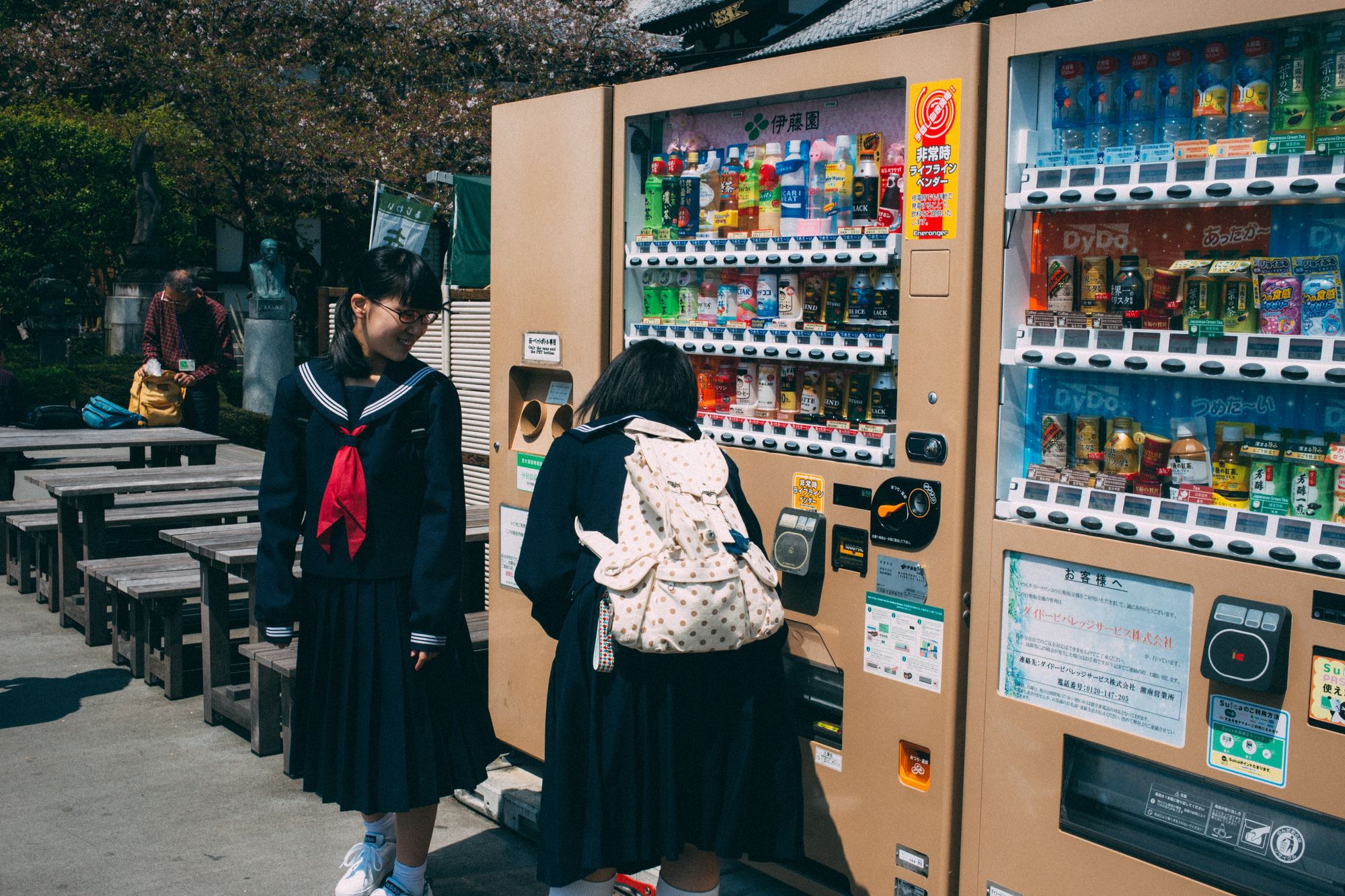
Let's take a look at some examples to help you master your Hiragana pronunciation:
GA - ZA - DA - BA - PA
- ga - indicates subject or occasionally object
- gakkou - school
- gakushya - scholar, academic
- gakusei - student
- gaikoku - foreign country
- gaikokujin - foreigner
- gaman - self control
- gakki - musical instrument
- ganseki - rock
- gake - cliff
- zannen - too bad; regrettable or unfortunate
- zaisan - propert; fortune; assets
- zaseki - seat
- zabuton - flat floor cushion used when sitting or kneeling
- zaisei - public finance
- zaiko - stock; inventory
- zai - fortune; riches
- zairyou - materials; ingredients
- zatsuon - noise; interference; gossip
- zaimoku - lumber or timber
- daigaku - university
- daisuki - I love you; to like very much
- daidokoro - kitchen
- dansei - man
- daitouryou - president
- dasu - to take out
- daijobu - to be okay; safe; secure
- dandan - gradually; by degrees; little by little
- daikon - radish
- baka - idiot
- bangou - number
- ban - evening; night
- bangohan - dinner
- bangumi - TV program
- bashyo - place; location; spot
- baachan - grandmother
- bakudan - bomb
- bassuru - to punish or penalize
- baiten - stand; stall; kiosk
*There are no hiragana words that start with PA
- yappari - actually; as I thought
- denpa - cell signal; radio waves
- suppai - sour
- shyoppai - salty
- ippai - full, a lot
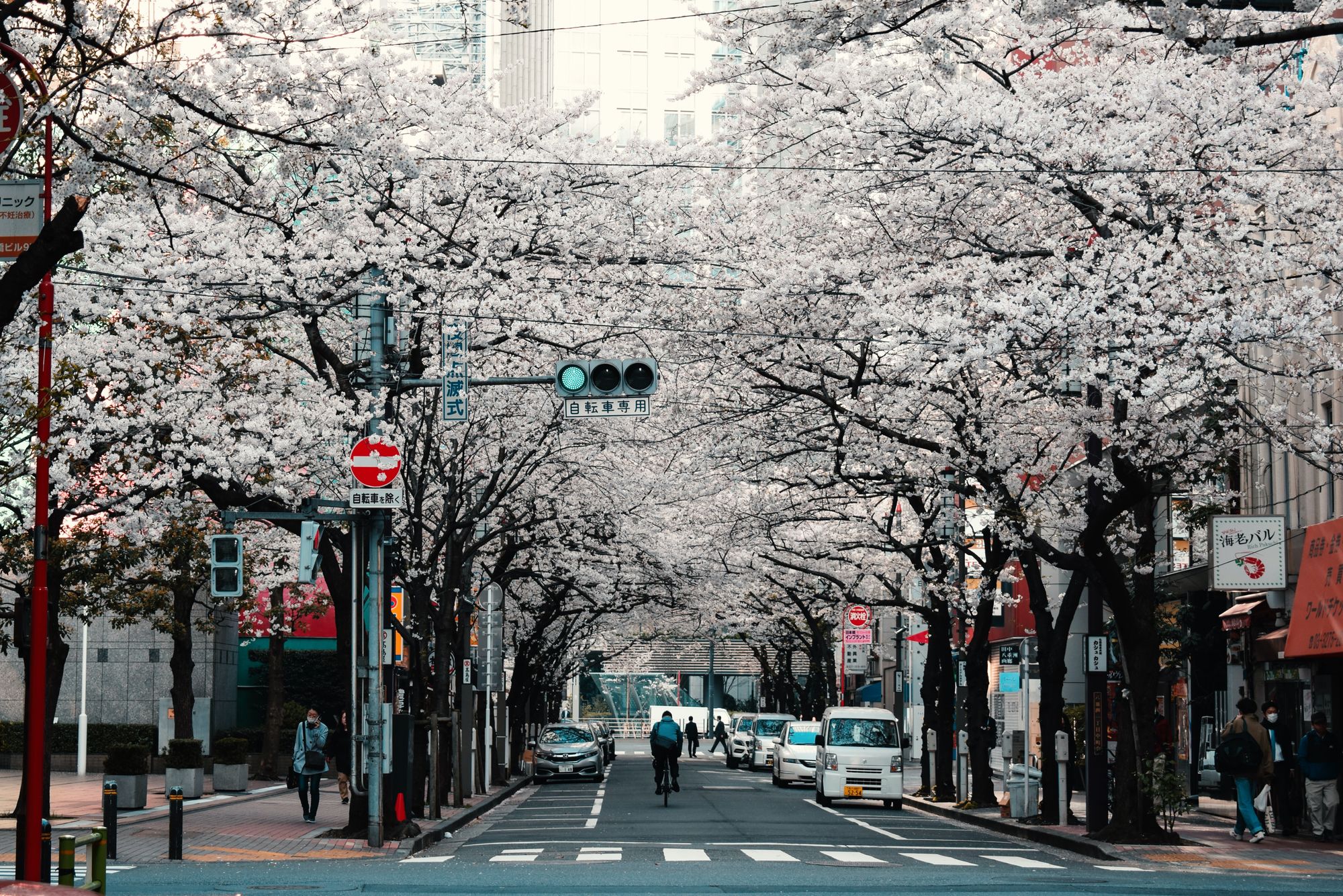
Writing Hiragana Characters
Writing Japanese is essential for learning Hiragana, Katakana, and Kanji.
In Japan, good handwriting and stroke order are highly valued and calligraphy is an art praised in Japanese society.
Not only will writing practice help you connect each character to each sound, but it will help you discern between similar-looking ones and greatly improve the speed at which you can read Hiragana.
Here are a few ways to practice writing in Japanese:
Write your own Hiragana chart
This will be the base of your entire Hiragana practice. After you have written it out once, challenge yourself to start from different sections and fill in all the blanks.
Not only will you learn stroke order and teach yourself the sound for each and every character, but you can refer to this Hiragana chart throughout your studies.
Make your own Hiragana flash cards
Flash cards are crucial to teach yourself new Japanese words. Start by writing one syllable at a time; put the Hiragana character on one side and the English letters on the other.
After some time, write an English word on one side, and a Japanese word on the other. Your next task from there would be to make flashcards to practice sentences and phrases.
Create your own mnemonics
Remember silly phrases like " P lease E xcuse M y D ear A unt S ally" to memorize the mathematical order of operations PEMDAS? These tricks are called mnemonic devices, where we usually use an English word to represent each letter of a long acronym.
Well, you can apply the same strategy to learning Japanese. The key is trying to ascribe an image to the shape of each Hiragana character.
For example, the 'yo' sound (よ) could look like a person waving for attention and saying "yo!" Maybe the sound 'e' (え) could look like a person running, and you could associate it with a quirky phrase like, "I could n e ver run that fast."
Have fun with it and try to invent your own mnemonics for other sounds!
Learning Hiragana Through Video
Perhaps the best thing you could do to practice your listening and reading is to start watching Japanese movies and TV shows with subtitles.
By engaging with Japanese media, you will be able to hear how Japanese is naturally spoken, and pick up on social cues and colloquialisms you might not find in typical Japanese textbooks.
And if you're going to binge on television for a few hours, you might as well use that time to learn Japanese and teach yourself a thing or two!
A website like Lingopie provides a wide array of Japanese resources to help you learn Hiragana, Katakana, and eventually Kanji while watching Japanese movies and TV shows.
With Lingopie, you can access many popular Japanese anime, movies, and TV shows you might find on Netflix.
However, on top of this, Lingopie also provides online tools like interactive subtitles and flashcards to make learning Hiragana and Japanese as a whole a lot easier and more convenient.
For access to a diverse selection of great Japanese TV shows and films, sign up for Lingopie. This streaming service offers quality Japanese shows and films that are optimal for practicing both Hiragana and Katakana.
FAQs Relating to the Japanese Alphabet and Learning Hiragana characters
So, any questions so far? Hold that thought! Here are some commonly asked and answered FAQs. A lot of these questions address two key gripes that come with learning any language: strategy and time.
Hopefully these will lend some good advice and give you some direction. However, remember that consistency, dedication, and practice are key to learning Hiragana, Japanese, and any alphabet or language for that matter!
Is hiragana easy to learn?
Yes! Hiragana is a phonetic alphabet, so every character depicts one specific sound. There are 46 characters in total in the Hiragana script. A little time and practice are all it takes.
How can I memorize hiragana quickly?
Make a Hiragana chart. Start with all the basic Hiragana characters, and then move on to the transformations.
Make your own Hiragana flash cards. This is perhaps the most crucial exercise to learn Hiragana fast. Start with each individual sound, and then for every new word or phrase you learn.
These two memorization techniques can be applied to Katakana and Kanji as well.
What is a good way to learn hiragana?
Practice writing Hiragana! Keep a dedicated notebook for vocabulary. Sound out the syllables as you write them.
Read manga! Japanese graphic novels are a great place to start learning how to read Hiragana.
Immerse yourself in Japanese TV shows and movies. Use Lingopie's interactive subtitles and flashcards for a deeper understanding of Hiragana.
How long does it take to learn hiragana?
Learning the Hiragana alphabet can take as little as a few hours. After one afternoon of intense memorization, all you need to do is practice.

Summing up: Learn the Japanese Alphabet: A Guide to Hiragana
Now you know how manageable it is to start learning Japanese ! Mastering Hiragana only takes a little bit of time and effort and will open the door to learning Katakana and Kanji in the future.
As you've seen, learning Hiragana is a phonetic alphabet organized logically and systematically. There are only a few exceptions and transformations to be aware of.
We've covered a broad foundation up to this point, including basic and modified characters, a few examples of simple vocabulary for each, and some theory behind written Hiragana and how it translates to spoken Japanese.
Hopefully, you've been inspired to learn Hiragana with a few simple strategies. Be sure to practice writing, drill yourself using flashcards, and dedicate yourself to learning the pronunciation of each sound.
And remember, learning can be fun, too! Learning through films and TV shows is probably the best way to get feel for how people actually communicate in Japan using Hiragana.
We also recommend watching lots of Anime. We even made a list with some of the best Anime out there to get you started!
Don't forget to sign up for a 7-day free trial with Lingopie to start learning Japanese and Hiragana script through Japanese movies and TV shows.
Related: 9 Japanese Movies on Netflix for Japanese Learners

Lorena Macedo

Top 9 Songs to Learn French: Sing Your Way to Fluency with Lingopie Music
![learn to write japanese hiragana Common Italian Travel Phrases You Need to Learn [Language Tips]](https://lingopie.com/blog/content/images/size/w1200/2022/10/Common-Italian-Travel-Phrases-You-Need-to-Learn.webp)
Common Italian Travel Phrases You Need to Learn [Language Tips]
You might also like.

How to Count in Japanese From 1-100

Master the Basics: How to Quickly Count in Japanese

Japanese Valentine's Day Guide
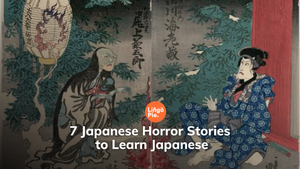
7 Japanese Horror Stories to Learn Japanese
Get the secret guide to language learning with tv and music for free, browse posts by popular tags.

The Best Hiragana & Katakana Learning Resources How to & What To Use for Studying "Kana" Characters Efficiently
August 10, 2023 • words written by Kanae Nakamine • Art by Aya Francisco
Hiragana and katakana are literally the ABCs of Japanese. They're the most basic types of Japanese characters and essential parts of the Japanese language. Learning these two types of characters is often the very first step to learning Japanese, too.
Being able to read hiragana and katakana is amazing because it's such an immediately practical skill. You see them everywhere in Japan. The scenery of Japan, or even your neighborhood Asian grocery store may start to look different once you know hiragana and katakana.
Luckily, they're fairly easy to master, too. No, you don't need a photographic memory or superpower to memorize all of them. All you need is the right method and tools to study effectively and efficiently.
There are 46 hiragana characters for hiragana and katakana respectively. Memorizing 92 characters with unfamiliar shapes might sound intimidating now, but trust me. People have learned them in a couple weeks, a few days, or even a few hours with these effective methods.
If you want to study hiragana and katakana fairly quickly, and never forget them, you've come to the right place. I'll talk about how you can do it, and introduce some of the best kana learning resources you can use for a successful kana learning experience.
1. Use memory hints aka "mnemonics"
2. prioritize "reading" over "writing", 3. practice recalling, tofugu's learn hiragana/katakana books, hiragana/katakana memory hint, learn languages with dr. moku (hiragana & katakana), learn all hiragana/katakana in 1 hour - how to write and read japanese (japanesepod101.com), tofugu's learn kana quiz, how to learn hiragana & katakana.
First, let me go through the three key points for successful kana learning.
Memory hints, aka mnemonics, are honestly the game changer in remembering foreign characters like hiragana, katakana, and even kanji. Using mnemonics, you can easily associate the shape of kana with the reading. Curious how mnemonics actually work? Here's an example to remember hiragana "ki" (き). This one is pretty simple. Just think of a key ! 🔑

Remembering a bunch of unfamiliar shapes suddenly sounds doable, right? Mnemonics make things easy to remember, recall, and not forget. It really is a powerful tool for kana learning.
Focus on reading first. Not writing. I know, it's not the traditional way children learn their characters. But, learning to read is more important as the most common form of "writing" nowadays is typing. (If you can read kana, you can type them.)
Being able to handwrite hiragana from memory is a great skill to have too, but it takes a lot more time to master and has fewer real-life benefits. I recommend you save it for later. Handwriting or tracing over the characters with your fingers can be a great way to spend time observing the shapes closely, but always keep in mind the "reading" priority rather than being able to handwrite from your memory. At least, for now.
Once you become familiar with the kana, practice reading repeatedly. Make sure to review items you've learned and keep it up. And when you review, focus on your recall. The more effort you put into recalling something, the stronger memory your brain will end up building.
The Best Resources for Learning Hiragana/Katakana
So now that we've talked about the three key points for successful kana learning, you may be thinking, "What tools can I use to learn hiragana and katakana?"
I got you — I put together a list of some of the best kana learning resources. They, of course, have small differences, but they all feature mnemonics and reading practice, which are the key points for successful kana learning.
Now, let's take a closer look at each resource.

Before anything, let me talk about Tofugu's own products — our Learn Hiragana/Katakana Book series. This is a shameless plug as I am very proud of all the learners who successfully learned kana with our books and proved them to be effective. They're also available for free, so nothing to lose if you give them a try.
Tofugu's Learn Hiragana/Katakana Book series consists of two PDF workbooks, so you can print or use them on your device offline. The workbooks cover everything you need to know about hiragana and katakana. You'll learn how to pronounce, and how to remember each character with mnemonics and writing practice sheets. There are also reading practice exercises to help you review what you've just learned by filling in romaji. The quiz uses actual words made from the characters you've learned, creating a rewarding moment that hopefully makes you go "Woah, I can read Japanese words!" and motivates you to keep going.
More than anything, the ultimate focus of our content is the quality of mnemonics. We've been updating and improving our mnemonics ever since we first published them, and that's what makes our kana content special. For example, to explain the pronunciation of each kana, we use an English word that uses the same or very similar sound so that you know exactly how to pronounce it. And, when possible, we use the English keyword for mnemonics too. For example, the hiragana い sounds just like "e" as in " ee l." And to help you associate the sound and the shape of the characters, we use the same keyword "eel," and say い looks like two eels hanging out. Another common mnemonic for い is that it looks like the number e leven as in 11 (which, it totally does!) but we choose "eels" for the more accurate pronunciation. We believe that learning kana is also about learning the sounds of the Japanese language and the basics of Japanese pronunciation, so we hope those keywords help you remember the correct pronunciation.
We also keep our mnemonic art simple in a way that makes it easy to see the original shape of the character. Not many mnemonics out there have this quality, and it's sometimes hard to recognize the original shape in the mnemonic art.
If you are looking for a one-stop solution for kana learning, you won't be disappointed with Tofugu's Learn Hiragana/Katakana Books.
For those who want to be able to listen to the pronunciation of each kana …
we have web page versions too — Learn Hiragana: The Ultimate Guide and Learn Katakana: The Ultimate Guide . While these don't come with writing sheets, you can play the audio, which is always a bonus.
So there you have it. We actually have more kana learning tools in various formats and for different purposes, so check out the list below to find something that suits your preference and needs. You can mix and match too — they're all free!
- Learn Hiragana: The Ultimate Guide
- Learn Katakana: The Ultimate Guide
- Learn Hiragana Today
- The "Hiragana Mnemonics Chart," by Tofugu
- Tofugu's Official Anki Deck: Hiragana , Katakana

HIRAGANA Memory Hint and KATAKANA Memory Hint are mobile apps to help you learn kana with memory hints (aka mnemonics). Developed by The Japan Foundation Japanese-Language Institute, Kansai, both apps are available for free. The apps are divided into two parts: Memory Hints and Quiz.
The memory hints are overall helpful and intuitive, and they all come with cute illustrations. If anything, the unique art style makes it a bit hard to recognize the original characters in the illustration. Many of the illustrations sort of modify the shapes to make sense of the visual mnemonics (or at least, many look a lot different from generic font text). So if you ever use these apps, keep that in mind, and make sure to compare the illustration to what the character actually looks like. There are a couple options in the app that help you with this; one to see the mnemonic illustration and the original side by side, and another to play an animation of the illustration gradually fading out and the original character appearing after that.
If you go to the Quiz screen, there are four types of quizzes you can select from. In addition to the typical practice of choosing the corresponding romaji reading for each kana, the options include Listen & Choose , where you hear a sound and choose a corresponding kana out of three choices, and Similar Hiragana / Similar Katakana , where you see a sound written in romaji and choose a corresponding character out of two or three kana options that look alike, such as あ, め, and ぬ.
Another nice thing about the quiz feature is that you can narrow down the characters you want to practice by selecting a group(s) of kana. Each group contains two kana rows of eight to ten characters. Not many people cram all the kana in one sitting, so it's nice to be able to select and practice the kana you just became familiar with, before moving forward to study more.
However, it's worth noting these quizzes are all in multiple-choice format. Compared to typing or writing, it's a less strict method of testing your knowledge, or practicing your recall. But if you prefer easing into kana with a more relaxed approach, this could be a good option. Regardless of your answer being correct or not, you'll be shown the mnemonic illustration of the answer right after you answer each question. It's a nice gesture for people who had a hard time recalling most of the characters, but this feels redundant when you try to get through the session as quickly as possible or when you're already confident and don't need to see them. Quiz sessions are timed to motivate people to go through quickly, so being shown the mnemonic image can feel extraneous.
Overall, despite minor details that you may wish to change, HIRAGANA/KATAKANA Memory Hint is a legitimate option to learn kana with the help of mnemonics. And it's free!
As a side note… As of reviewing the apps (February, 2023), the audio was unfortunately not working at all on my iPhone 13 mini. Audio play buttons to check the pronunciation of each character doesn't work, and the Listen & Choose quiz doesn't play the audio either.

Learn Languages with Dr. Moku is a mobile app that uses the power of mnemonics to help visual learners study the characters of foreign languages, including Japanese — hiragana, katakana, and even basic kanji. In their hiragana and katakana courses, you'll be presented with mnemonic illustrations and a short phrase or two to help you associate the shape of the character with how it's pronounced.
Upon tapping the mnemonic image, it plays an animated version of the visual mnemonic (You'll hear Dr. Moku reading the mnemonic aloud for you!), then an animation showing how the character is written following its stroke order. Many mnemonics are clever, but just be aware that there are some pop culture references used in the mnemonics, such as Mr. T or Ed Sheeran, which may not be relatable to everyone.
Following mnemonics is an audio play button to hear the pronunciation along with some useful information about each character — how to pronounce it or where you might see the character. It also shows a few words where the character is used.
After learning a set of characters, you'll be prompted with quizzes to review what you've just learned. It offers various formats of quizzes, such as typing in romaji, and selecting a character corresponding to the sound you hear. It quizzes you with not only single characters but also sometimes words that are made out of multiple characters.
The app overall has a great design and quality illustrations and animations, but you have to pay for what you get — it's not free to learn all the kana. You can use it for free to study eleven hiragana and eight katakana, but after that, you'll have to make a one-time in-app purchase to upgrade to the full kana coverage. Each kana package costs $5.99, but there's a Japanese Bundle package for $7.99, which includes both kana as well as basic kanji and a phrase book.
The upgrade also unlocks some bonus features, including a practice tool where you can do extra quizzes, but this practice feature won't really be useful until you're already familiar with the whole set of 46 basic kana plus variation characters. You can choose how many questions you want to go through in a session, but it doesn't consider what kana you've already learned on the app, nor does it let you select kana you're already familiar with and want to quiz.
Learn ALL Hiragana/Katakana in 1 Hour is a series of two video lessons available for free on YouTube. Each video is an hour long, focusing on either a whole set of hiragana or katakana. The video gives an overview of hiragana and katakana using graphics and charts, then goes through each character to help you remember how to write and read them. Each character is introduced with the stroke order of the character, and what the character looks like in different kinds of fonts. They also show an illustration mnemonic for each character to make it easy to remember. You'll also hear a brief explanation of where you might see the character in Japanese grammar. When they introduce a new kana that has a similar shape to the one you've already learned, they take the time to compare and explain the differences.
Once each column (a set of three to five characters) is introduced, they do a quick quiz to review, showing you the characters you've just learned while giving you a moment to recall how they're pronounced. Some quizzes use actual words where the character appears.
The host of the video lessons, Risa, is a native speaker of Japanese, so you get to hear her authentic pronunciation of each character. However, keep in mind there's sometimes a gap between the actual Japanese sound and the English keywords they use in their mnemonics. For example, they encourage you to think of the shape of an a pple to remember a hiragana あ (a). However, あ is closer to the sound of " a h" (ɑ), not " a pple" (æ). This may trip you up, so try focusing on how the host reads the character, rather than the mnemonic keywords for accurate pronunciation.
They do cover all the kana in an easy-to-understand way using illustrations and animations. However, an hour long video lesson is a lot to pack in. If you're interested in using this video lesson series for learning kana, don't force yourself to go through it all in one sitting.
The series is created by JapanesePod101.com , who are known for offering a huge amount of Japanese learning content. However, at the same time, their content organization tends to be difficult to navigate. For example, these YouTube videos don't have timestamps, so you may find it hard to keep coming back to where you left off.
If you prefer a collection of bite-size lessons, you can check out the 10-Day Hiragana Challenge and 10-Day Katakna Challenge playlists. Each of the two videos from the Learn ALL Hiragana/Katakana in 1 Hour series are divided into ten parts with videos just several minutes long. The downside of this 10-Day Challenge series though is that it includes more advertisements for JapanesePod101.com products.
For Extra Quiz Practice and Reviews
The resources that I've talked about so far are all one-stop solutions that help you remember kana with mnemonics and review and practice through quizzes. As I've mentioned, kana is everywhere. Once you start studying other aspects of the Japanese language, you'll see them constantly. So in a way, you'll be naturally reinforcing your kana knowledge moving forward. That said, you'll want to first practice a lot and make sure you solidify your kana knowledge.
You can get some practice in with the resources above, but I also wanted to introduce you to a couple other tools specifically designed to quiz your kana knowledge for extra practice. One standout feature is that they let you actually type in romaji for the kana readings instead of just offering you multiple choice answers. This means they are a better assessment of your true kana knowledge, and can help you identify what kana you might be struggling to remember.
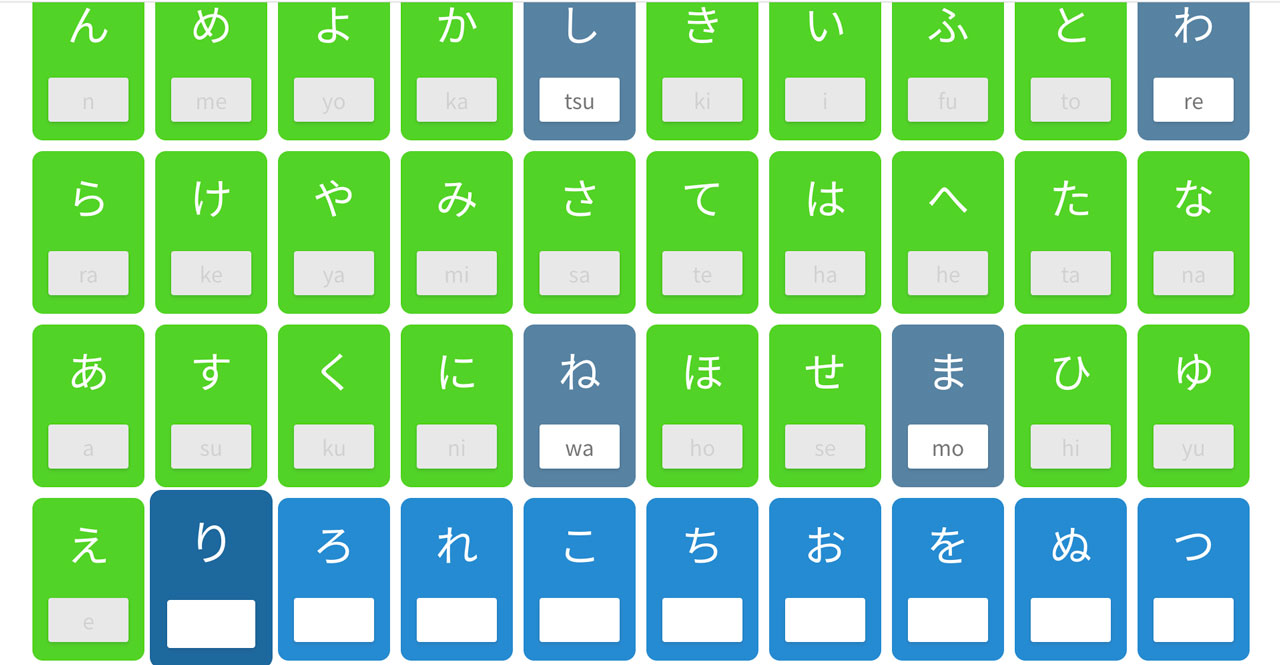
This is another shameless plug (okay okay, I promise this will be the last).
Tofugu's Learn Kana Quiz is a web app originally designed to be a quiz tool to help you solidify the kana knowledge from our kana products, such as the workbooks and web pages I introduced earlier. However, it would be a great companion for really any kind of kana-learning resource as what it does is allow you to practice whatever kana you want, as many times as you want. It also helps you to identify the characters you still have a hard time with.
The way it works is simple. On the main page, you get to choose the kana you want to practice by column (a set of three to five characters). You can check all hiragana or all katakana with a single button too, if you're already familiar with all the kana listed.
During the quiz, you'll be prompted with a set of the selected hiragana characters and asked to type in the readings for each one. You can choose to skip items so you can save the ones you have a hard time recalling and circle back on those later. We believe the act of recalling is important, so unlike any other quiz tools, we actually won't tell you the correct answer even when you get things wrong. (We intentionally make it hard to cheat, and it's all for you!) However, you can try answering the same item until you type in the right answer so you can test your recall over and over.
Then, when you finish a session, the results show you how many failed attempts you had with the characters you couldn't answer correctly at the first go. This will help you identify what kana characters are not still sticking in your memory so you can do something about them — revisiting the mnemonics, inventing new mnemonics, or tracing the characters — whatever you gotta do to finally remember them!
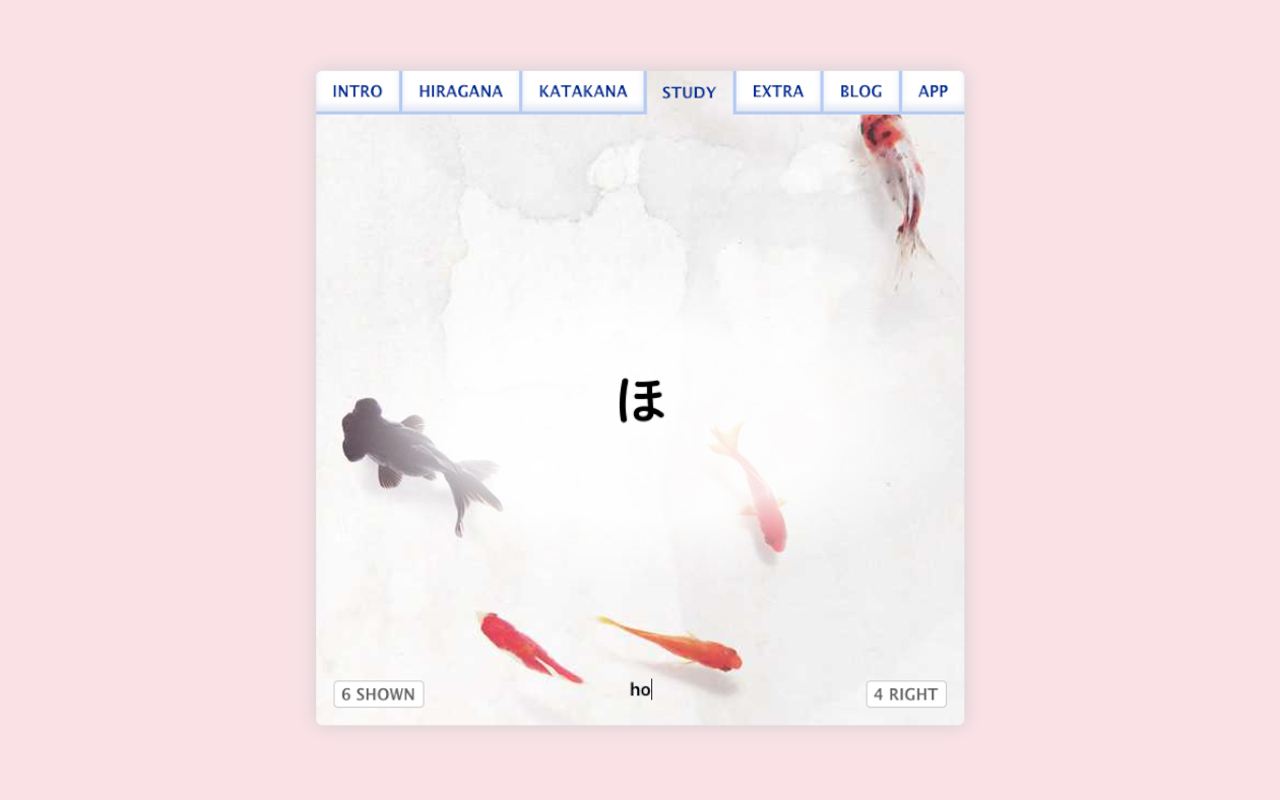
So this is it! Hope you found something that you want to give a try in this article. Again, being able to read kana is a big first step, and it's not as hard as you think. I hope the methods and resources that I talked about will give you a great head start on your Japanese learning journey! Happy Kana Learning!
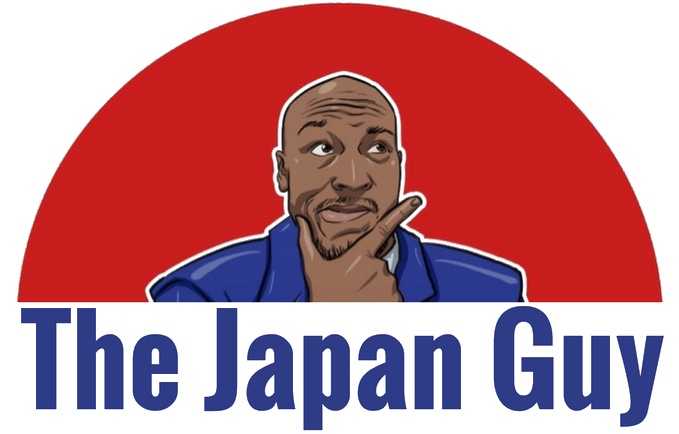
- Let’s Learn Hiragana Stroke Order
By Donald Ash | Japanese Language Basics
- You are here:
- Japanese Language Basics
The best place to start with hiragana is by making sure your can recognize the symbols and connect the phonetic sounds each one in your mind. The next step is what we're going to focus on today. We're going to take a closer look at hiragana stroke order. But before we do, let's see if you can recognize the sounds associated with these five symbols.
How do you pronounce the following, characters? No cheating! The answers are at the very bottom of the post 1. ら 2. つ 3. ろ 4. す 5. い
How did you do? I hope you got them all right, but if not, no worries. Go back and drill those sounds until you have them.
What is stroke order? If I had to put it in my own words, I would say stroke order is the direction and order in which you draw the lines of a hiragana character .
I know many of you may be wondering “Why does the order of these freakin’ characters matter?” Well, you’ll need this later. With hiragana , the characters are quite simple (many having just two or three strokes) and you could potentially follow your own method and sketch out the same character rather easily. However, I honestly don’t recommend it.
Though you may not realize it when you’re just starting out, if you’re looking to build upon your Japanese writing skills, stroke order will play a HUGE role in being able to write kanji. For example, the character "yo" 曜 (which means weekday) has 18 strokes! Whether you're writing this symbol, or looking it up, it’s good to have a general idea of the way things are written.
In the same fashion as our previous article, we will break the characters down into eight groups of five and two groups of three.
HIRAGANA STROKE ORDER - GROUP 1 A, I, U, E, O
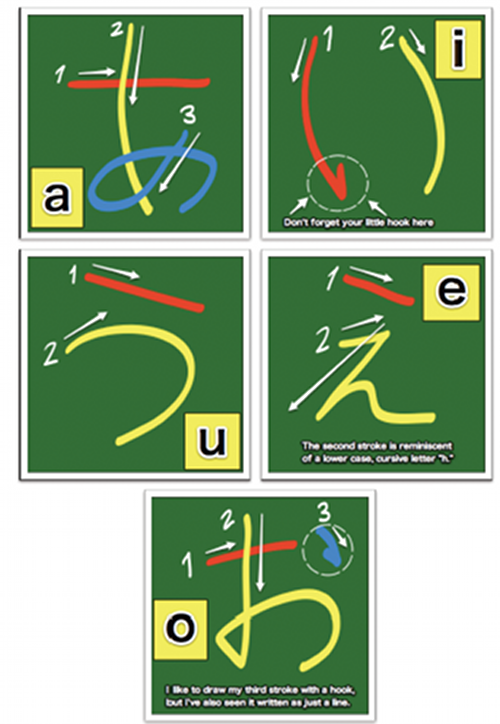
GROUP 2 KA, KI, KU, KE, KO
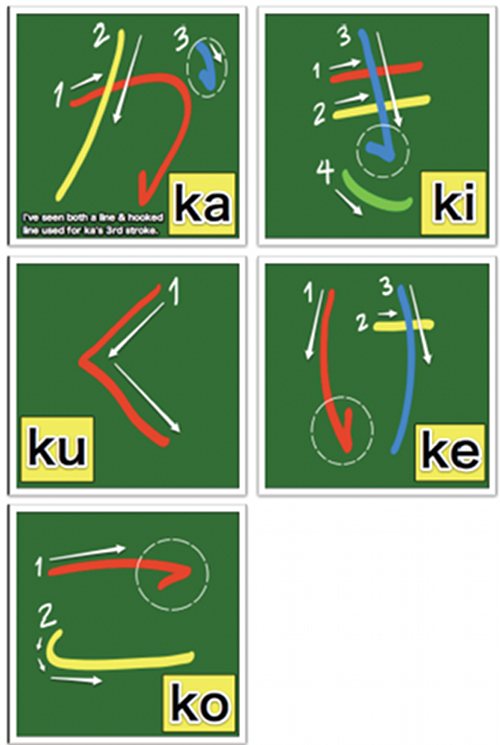
GROUP 3 SA, SHI, SU, SE, SO
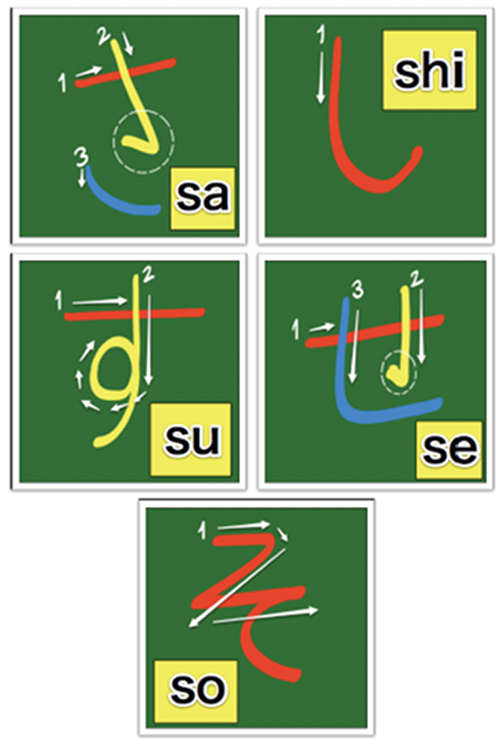
GROUP 4 TA, CHI, TSU, TE, TO
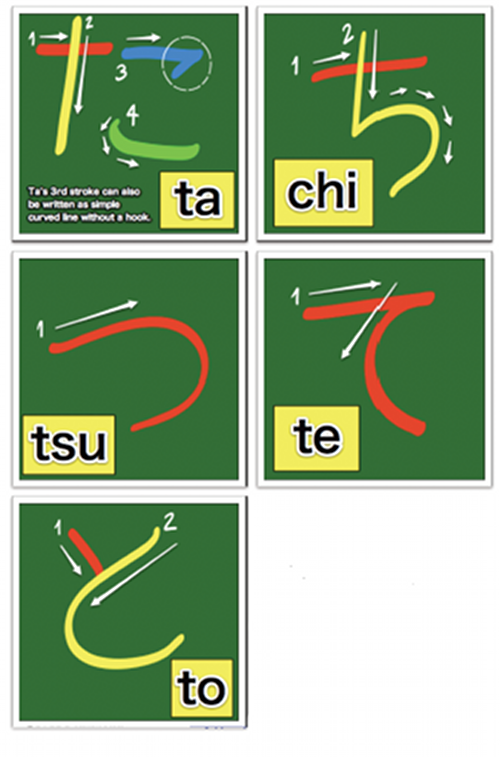
GROUP 5 NA, NI, NU, NE, NO

GROUP 6 HA, HI, FU, HE, HO
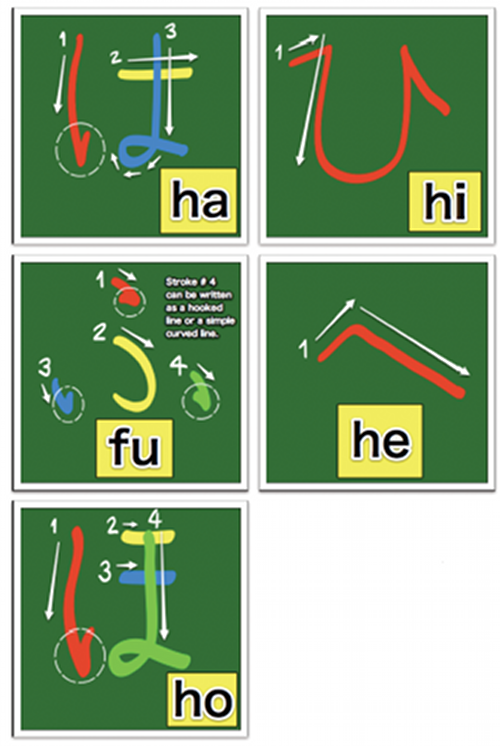
GROUP 7 MA, MI, MU, ME, MO
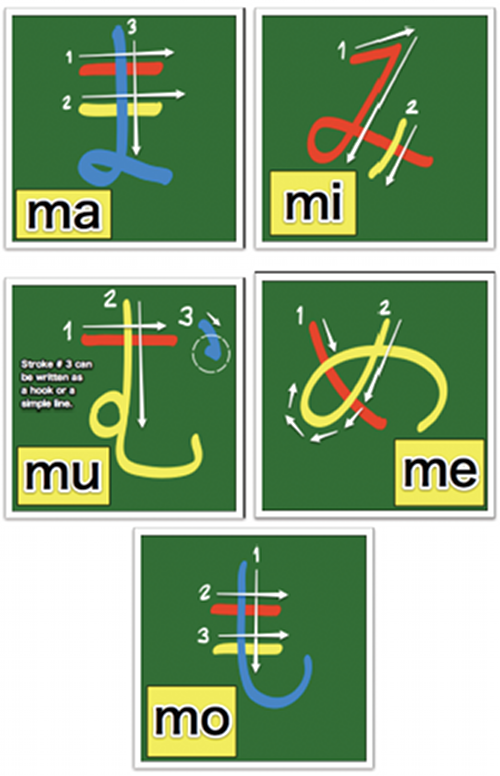
GROUP 8 YA, YU, YO
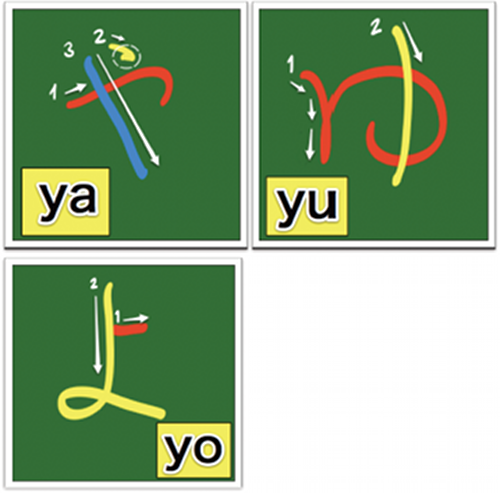
GROUP 9 RA, RI, RU, RE, RO
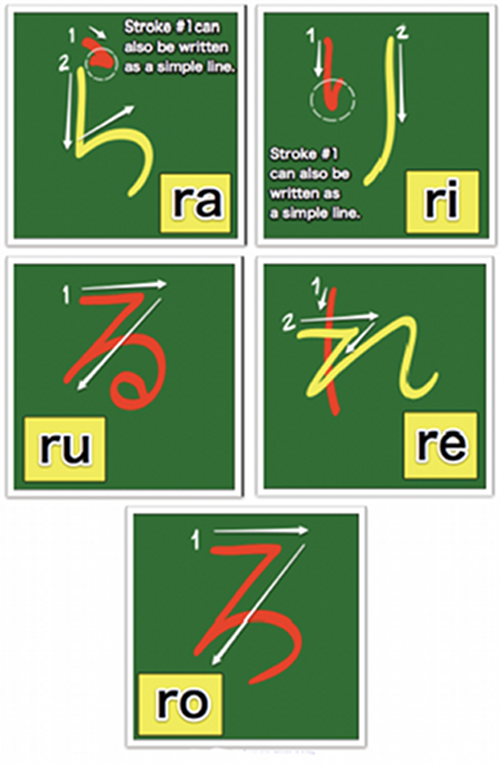
GROUP 10 WA, WO, N
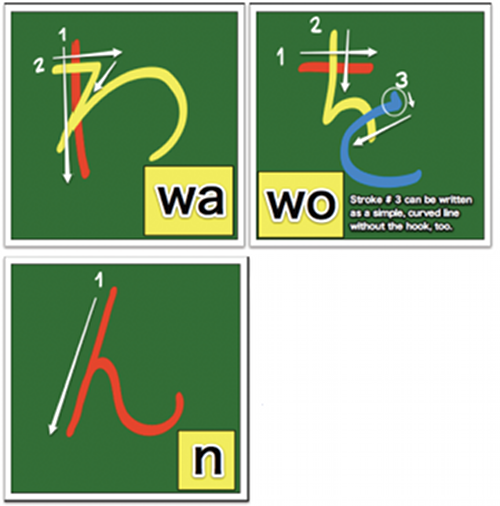
You made it! That’s the stroke order for all 46 characters. CONGRATULATIONS! As with nearly anything, repetition (even just a little bit each day) is key to locking the hiragana stroke order into your brain.
POP QUIZ ANSWERS:
1. Ra 2. Tsu 3. Ro 4. Su and 5. I
Need Video Help With These?
If video is more effective for you and you'd rather see exactly how the hiragana symbols are written, I created a FREE video tutorial just for you! Click the play button, enter your name & email, and that will be delivered straight to your inbox. I HOPE IT HELPS!
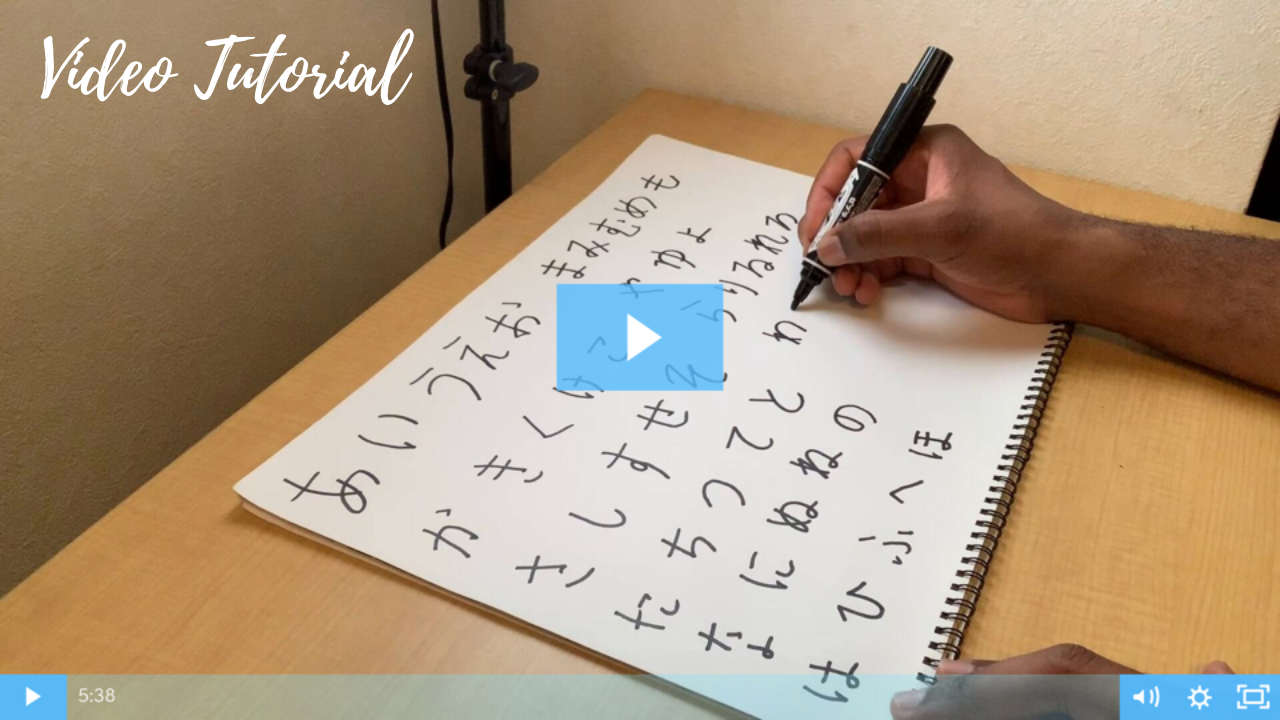
About the Author
Donald Ash is an Atlanta, Georgia-born, American expat who has been living in a Japanese time warp for the last eleven years. While in that time warp, he discovered that he absolutely loves writing, blogging, and sharing. Donald is the creator of thejapanguy.com blog. Wanna know more about this guy? Check out his "What's Your Story" page.
I always like the reaction, when i write kanji, your order is wrong! can you read it? yes, so what is the problem? But your order is wrong! :p
says>>>>>G
DONT READ DO NOT READ THIS. ON THE NEAREST FRIDAY U WILL BE KISSED BY YOUR TRUE LOVE. THAT IS ONLY IF U POST THIS TO 5 OTHER GAMES. IF U DON’T U ARE DEAD IN TWO DAYS. U HAVE ONE HOUR TO DO THIS AFTER U READ IT hfdgddhfsggsfhgdjgdbgfc
It was fantastic learning through your method. My mail I’d is [email protected] . Pl send any useful tips to learn japanese.
you forgot wi and we!
An effective way to master hiragana is to practise writing in it. One can practise writing in hiragana easily with an online Japanese IME like https://www.hiraganakeyboard.com
This was a incredibly helpful thank you : ).
Session expired
Please log in again. The login page will open in a new tab. After logging in you can close it and return to this page.
Don't Forget This!

In this over-the-shoulder video tutorial, I'll personally walk you through all 46 hiragana characters and their stroke order. Just enter your name and email and that'll be delivered right to your inbox.
Let's Practice Together...
I'll walk you through each hiragana character, step-by-step. Just let me know where to send the video. Please enter your name and email below.
Welcome to Kakimashou
Practice writing Japanese on your screen. Let's write!
Learning to write in Japanese takes a lot of practice, but this website will take care of a lot of the legwork for you. You can stop wasting paper and looking up stroke-order diagrams and just focus on learning.
Begin Tutorial
Send Feedback
Support this Website
- Skip to primary navigation
- Skip to main content
- Skip to primary sidebar
- Skip to footer
StoryLearning
Learn A Language Through Stories
How To Write In Japanese – A Beginner’s Guide
Do you want to learn how to write in Japanese , but feel confused or intimidated by the script?
This post will break it all down for you, in a step-by-step guide to reading and writing skills this beautiful language.
I remember when I first started learning Japanese and how daunting the writing system seemed. I even wondered whether I could get away without learning the script altogether and just sticking with romaji (writing Japanese with the roman letters).
I’m glad I didn’t.
If you’re serious about learning Japanese, you have to get to grips with the script sooner or later. If you don’t, you won’t be able to read or write anything useful, and that’s no way to learn a language.
The good news is that it isn’t as hard as you think. And I’ve teamed up with my friend Luca Toma (who’s also a Japanese coach ) to bring you this comprehensive guide to reading and writing Japanese.
By the way, if you want to learn Japanese fast and have fun while doing it, my top recommendation is Japanese Uncovered which teaches you through StoryLearning®.
With Japanese Uncovered you’ll use my unique StoryLearning® method to learn Japanese naturally through story… not rules. It’s as fun as it is effective.
If you’re ready to get started, click here for a 7-day FREE trial.
If you have a friend who’s learning Japanese, you might like to share it with them. Now, let’s get stuck in…
One Language, Two Systems, Three Scripts
If you are a complete beginner, Japanese writing may appear just like Chinese.
But if you look at it more carefully you'll notice that it doesn’t just contain complex Chinese characters… there are lots of simpler ones too.
Take a look.
それでも、 日本人 の 食生活 も 急速 に 変化 してきています 。 ハンバーグ や カレーライス は 子供に人気 がありますし 、都会 では 、 イタリア 料理、東南 アジア 料理、多国籍料理 などを 出 す エスニック 料理店 がどんどん 増 えています 。
Nevertheless, the eating habits of Japanese people are also rapid ly chang ing . Hamburgers and curry rice are popular with children . In cities , ethnic restaurants serv ing Italian cuisine , Southeast Asian cuisine and multi-national cuisine keep increas ing more and more .
(Source: “Japan: Then and Now”, 2001, p. 62-63)
As you can see from this sample, within one Japanese text there are actually three different scripts intertwined. We’ve colour coded them to help you tell them apart.
(What’s really interesting is the different types of words – parts of speech – represented by each colour – it tells you a lot about what you use each of the three scripts for.)
Can you see the contrast between complex characters (orange) and simpler ones (blue and green)?
The complex characters are called kanji (漢字 lit. Chinese characters) and were borrowed from Chinese. They are what’s called a ‘logographic system' in which each symbol corresponds to a block of meaning (食 ‘to eat', 南 ‘south', 国 ‘country').
Each kanji also has its own pronunciation, which has to be learnt – you can’t “read” an unknown kanji like you could an unknown word in English.
Luckily, the other two sets of characters are simpler!
Those in blue above are called hiragana and those in green are called katakana . Katakana and hiragana are both examples of ‘syllabic systems', and unlike the kanji , each character corresponds to single sound. For example, そ= so, れ= re; イ= i, タ = ta.
Hiragana and katakana are a godsend for Japanese learners because the pronunciation isn’t a problem. If you see it, you can say it!
So, at this point, you’re probably wondering:
“What’s the point of using three different types of script? How could that have come about?”
In fact, all these scripts have a very specific role to play in a piece of Japanese writing, and you’ll find that they all work together in harmony in representing the Japanese language in a written form.
So let’s check them out in more detail.
First up, the two syllabic systems: hiragana and katakana (known collectively as kana ).
The ‘Kana' – One Symbol, One Sound
Both hiragana and katakana have a fixed number of symbols: 46 characters in each, to be precise.
Each of these corresponds to a combination of the 5 Japanese vowels (a, i, u, e o) and the 9 consonants (k, s, t, n, h, m, y, r, w).
(Source: Wikipedia Commons )
Hiragana (the blue characters in our sample text) are recognizable for their roundish shape and you’ll find them being used for three functions in Japanese writing:
1. Particles (used to indicate the grammatical function of a word)
は wa topic marker
が ga subject marker
を wo direct object marker
2. To change the meaning of verbs, adverbs or adjectives, which generally have a root written in kanji. (“Inflectional endings”)
急速 に kyuusoku ni rapid ly
増 えています fu ete imasu are increas ing
3. Native Japanese words not covered by the other two scripts
それでも soredemo nevertheless
どんどん dondon more and more
Katakana (the green characters in our sample text) are recognisable for their straight lines and sharp corners. They are generally reserved for:
1. Loanwords from other languages. See what you can spot!
ハンバーグ hanbaagu hamburger
カレーライス karee raisu curry rice
エスニック esunikku ethnic
2. Transcribing foreign names
イタリア itaria Italy
アジア ajia Asia
They are also used for emphasis (the equivalent of italics or underlining in English), and for scientific terms (plants, animals, minerals, etc.).
So where did hiragana and katakana come from?
In fact, they were both derived from kanji which had a particular pronunciation; Hiragana took from the Chinese cursive script (安 an →あ a), whereas katakana developed from single components of the regular Chinese script (阿 a →ア a ).
So that covers the origins the two kana scripts in Japanese, and how we use them.
Now let’s get on to the fun stuff… kanji !
The Kanji – One Symbol, One Meaning
Kanji – the most formidable hurdle for learners of Japanese!
We said earlier that kanji is a logographic system, in which each symbol corresponds to a “block of meaning”.
食 eating
生 life, birth
活 vivid, lively
“Block of meaning” is the best phrase, because one kanji is not necessarily a “word” on its own.
You might have to combine one kanji with another in order to make an actual word, and also to express more complex concepts:
生 + 活 = 生活 lifestyle
食 + 生活 = 食生活 eating habits
If that sounds complicated, remember that you see the same principle in other languages.
Think about the word ‘telephone' in English – you can break it down into two main components derived from Greek:
‘tele' (far) + ‘phone' (sound) = telephone
Neither of them are words in their own right.
So there are lots and lots of kanji , but in order to make more sense of them we can start by categorising them.
There are several categories of kanji , starting with the ‘pictographs' (象形文字 sh ōkei moji), which look like the objects they represent:
(Source: Wikipedia Commons )
In fact, there aren’t too many of these pictographs.
Around 90% of the kanji in fact come from six other categories, in which several basic elements (called ‘radicals') are combined to form new concepts.
For example:
人 (‘man' as a radical) + 木 (‘tree') = 休 (‘to rest')
These are known as 形声文字 keisei moji or ‘radical-phonetic compounds'.
You can think of these characters as being made up of two parts:
- A radical that tells you what category of word it is: animals, plants, metals, etc.)
- A second component that completes the character and give it its pronunciation (a sort of Japanese approximation from Chinese).
So that’s the story behind the kanji , but what are they used for in Japanese writing?
Typically, they are used to represent concrete concepts.
When you look at a piece of Japanese writing, you’ll see kanji being used for nouns, and in the stem of verbs, adjectives and adverbs.
Here are some of them from our sample text at the start of the article:
日本人 Japanese people 多国籍料理 multinational cuisine 東南 Southeast
Now, here’s the big question!
Once you’ve learnt to read or write a kanji , how do you pronounce it?
If you took the character from the original Chinese, it would usually only have one pronunciation.
However, by the time these characters leave China and reach Japan, they usually have two or sometimes even more pronunciations.
How or why does this happen?
Let's look at an example.
To say ‘mountain', the Chinese use the pictograph 山 which depicts a mountain with three peaks. The pronunciation of this character in Chinese is sh ā n (in the first tone).
Now, in Japanese the word for ‘mountain' is ‘yama'.
So in this case, the Japanese decided to borrow the character山from Chinese, but to pronounce it differently: yama .
However, this isn’t the end of the story!
The Japanese did decide to borrow the pronunciation from the original Chinese, but only to use it when that character is used in compound words.
So, in this case, when the character 山 is part of a compound word, it is pronounced as san/zan – clearly an approximation to the original Chinese pronunciation.
Here’s the kanji on its own:
山は… Yama wa… The mountain….
And here’s the kanji when it appears in compound words:
火山は… Ka zan wa The volcano…
富士山は… Fuji san wa… Mount Fuji….
To recap, every kanji has at least two pronunciations.
The first one (the so-called訓読み kun'yomi or ‘meaning reading') has an original Japanese pronunciation, and is used with one kanji on it’s own.
The second one (called音読み on'yomi or ‘sound-based reading') is used in compound words, and comes from the original Chinese.
Makes sense, right? 😉
In Japan, there’s an official number of kanji that are classified for “daily use” (常用漢字 joy ō kanji ) by the Japanese Ministry of Education – currently 2,136.
(Although remember that the number of actual words that you can form using these characters is much higher.)
So now… if you wanted to actually learn all these kanji , how should you go about it?
To answer this question, Luca’s going to give us an insight into how he did it.
How I Learnt Kanji
I started to learn kanji more than 10 years ago at a time when you couldn't find all the great resources that are available nowadays. I only had paper kanji dictionary and simple lists from my textbook.
What I did have, however, was the memory of a fantastic teacher.
I studied Chinese for two years in college, and this teacher taught us characters in two helpful ways:
- He would analyse them in terms of their radicals and other components
- He kept us motivated and interested in the process by using fascinating stories based on etymology (the origin of the characters)
Once I’d learnt to recognise the 214 radicals which make up all characters – the building blocks of Chinese characters – it was then much easier to go on and learn the characters and the words themselves.
It’s back to the earlier analogy of dividing the word ‘telephone' into tele and phone .
But here’s the thing – knowing the characters alone isn’t enough. There are too many, and they’re all very similar to one another.
If you want to get really good at the language, and really know how to read and how to write in Japanese, you need a higher-order strategy.
The number one strategy that I used to reach a near-native ability in reading and writing in Japanese was to learn the kanji within the context of dialogues or other texts .
I never studied them as individual characters or words.
Now, I could give you a few dozen ninja tricks for how to learn Japanese kanji. B ut the one secret that blows everything else out of the water and guarantees real success in the long-term, is extensive reading and massive exposure.
This is the foundation of the StoryLearning® method , where you immerse yourself in language through story.
In the meantime, there are a lot of resources both online and offline to learn kanji , each of which is based on a particular method or approach (from flashcards to mnemonic and so on).
The decision of which approach to use can be made easier by understanding the way you learn best.
Do you have a photographic memory or prefer working with images? Do you prefer to listen to audio? Or perhaps you prefer to write things by hands?
You can and should try more than one method, in order to figure out which works best for you.
( Note : You should get a copy of this excellent guide by John Fotheringham, which has all the resources you’ll ever need to learn kanji )
Summary Of How To Write In Japanese
So you’ve made it to the end!
See – I told you it wasn’t that bad! Let’s recap what we’ve covered.
Ordinary written Japanese employs a mixture of three scripts:
- Kanji, or Chinese characters, of which there are officially 2,136 in daily use (more in practice)
- 2 syllabic alphabets called hiragana and katakana, containing 42 symbols each
In special cases, such as children’s books or simplified materials for language learners, you might find everything written using only hiragana or katakana .
But apart from those materials, everything in Japanese is written by employing the three scripts together. And it’s the kanji which represent the cultural and linguistic challenge in the Japanese language.
If you want to become proficient in Japanese you have to learn all three!
Although it seems like a daunting task, remember that there are many people before you who have found themselves right at the beginning of their journey in learning Japanese.
And every journey begins with a single step.
So what are you waiting for?
The best place to start is to enrol in Japanese Uncovered . The course includes a series of lessons that teach you hiragana, katakana and kanji. It also includes an exciting Japanese story which comes in different formats (romaji, hiragana, kana and kanji) so you can practice reading Japanese, no matter what level you're at right now.
– – –
It’s been a pleasure for me to work on this article with Luca Toma, and I’ve learnt a lot in the process.
Now he didn’t ask me to write this, but if you’re serious about learning Japanese, you should consider hiring Luca as a coach. The reasons are many, and you can find out more on his website: JapaneseCoaching.it
Do you know anyone learning Japanese? Why not send them this article, or click here to send a tweet .
Language Courses
- Language Blog
- Testimonials
- Meet Our Team
- Media & Press
Download this article as a FREE PDF ?
What is your current level in Swedish?
Perfect! You’ve now got access to my most effective [level] Swedish tips…
Where shall I send the tips and your PDF?
We will protect your data in accordance with our data policy.
What is your current level in Danish?
Perfect! You’ve now got access to my most effective [level] Danish tips…
NOT INTERESTED?
What can we do better? If I could make something to help you right now, w hat would it be?
Which language are you learning?
What is your current level in [language] ?
Perfect! You’ve now got access to my most effective [level] [language] tips, PLUS your free StoryLearning Kit…
Where shall I send them?
Download this article as a FREE PDF?
Great! Where shall I send my best online teaching tips and your PDF?
Download this article as a FREE PDF ?
What is your current level in Arabic?
Perfect! You’ve now got access to my most effective [level] Arabic tips…
FREE StoryLearning Kit!
Join my email newsletter and get FREE access to your StoryLearning Kit — discover how to learn languages through the power of story!
Download a FREE Story in Japanese!
Enter your email address below to get a FREE short story in Japanese and start learning Japanese quickly and naturally with my StoryLearning® method!
What is your current level in Japanese?
Perfect! You’ve now got access to the Japanese StoryLearning® Pack …
Where shall I send your download link?
Download Your FREE Natural Japanese Grammar Pack
Enter your email address below to get free access to my Natural Japanese Grammar Pack and learn to internalise Japanese grammar quickly and naturally through stories.
Perfect! You’ve now got access to the Natural Japanese Grammar Pack …
What is your current level in Portuguese?
Perfect! You’ve now got access to the Natural Portuguese Grammar Pack …
What is your current level in German?
Perfect! You’ve now got access to the Natural German Grammar Pack …
Train as an Online Language Teacher and Earn from Home
The next cohort of my Certificate of Online Language Teaching will open soon. Join the waiting list, and we’ll notify you as soon as enrolment is open!
Perfect! You’ve now got access to my most effective [level] Portuguese tips…
What is your current level in Turkish?
Perfect! You’ve now got access to my most effective [level] Turkish tips…
What is your current level in French?
Perfect! You’ve now got access to the French Vocab Power Pack …
What is your current level in Italian?
Perfect! You’ve now got access to the Italian Vocab Power Pack …
Perfect! You’ve now got access to the German Vocab Power Pack …
Perfect! You’ve now got access to the Japanese Vocab Power Pack …
Download Your FREE Japanese Vocab Power Pack
Enter your email address below to get free access to my Japanese Vocab Power Pack and learn essential Japanese words and phrases quickly and naturally. (ALL levels!)
Download Your FREE German Vocab Power Pack

Enter your email address below to get free access to my German Vocab Power Pack and learn essential German words and phrases quickly and naturally. (ALL levels!)
Download Your FREE Italian Vocab Power Pack
Enter your email address below to get free access to my Italian Vocab Power Pack and learn essential Italian words and phrases quickly and naturally. (ALL levels!)
Download Your FREE French Vocab Power Pack
Enter your email address below to get free access to my French Vocab Power Pack and learn essential French words and phrases quickly and naturally. (ALL levels!)
Perfect! You’ve now got access to the Portuguese StoryLearning® Pack …
What is your current level in Russian?
Perfect! You’ve now got access to the Natural Russian Grammar Pack …
Perfect! You’ve now got access to the Russian StoryLearning® Pack …
Perfect! You’ve now got access to the Italian StoryLearning® Pack …
Perfect! You’ve now got access to the Natural Italian Grammar Pack …
Perfect! You’ve now got access to the French StoryLearning® Pack …
Perfect! You’ve now got access to the Natural French Grammar Pack …
What is your current level in Spanish?
Perfect! You’ve now got access to the Spanish Vocab Power Pack …
Perfect! You’ve now got access to the Natural Spanish Grammar Pack …
Perfect! You’ve now got access to the Spanish StoryLearning® Pack …
Where shall I send them?
What is your current level in Korean?
Perfect! You’ve now got access to my most effective [level] Korean tips…
Perfect! You’ve now got access to my most effective [level] Russian tips…
Perfect! You’ve now got access to my most effective [level] Japanese tips…
What is your current level in Chinese?
Perfect! You’ve now got access to my most effective [level] Chinese tips…
Perfect! You’ve now got access to my most effective [level] Spanish tips…
Perfect! You’ve now got access to my most effective [level] Italian tips…
Perfect! You’ve now got access to my most effective [level] French tips…
Perfect! You’ve now got access to my most effective [level] German tips…
Download Your FREE Natural Portuguese Grammar Pack
Enter your email address below to get free access to my Natural Portuguese Grammar Pack and learn to internalise Portuguese grammar quickly and naturally through stories.
Download Your FREE Natural Russian Grammar Pack
Enter your email address below to get free access to my Natural Russian Grammar Pack and learn to internalise Russian grammar quickly and naturally through stories.
Download Your FREE Natural German Grammar Pack
Enter your email address below to get free access to my Natural German Grammar Pack and learn to internalise German grammar quickly and naturally through stories.
Download Your FREE Natural French Grammar Pack
Enter your email address below to get free access to my Natural French Grammar Pack and learn to internalise French grammar quickly and naturally through stories.
Download Your FREE Natural Italian Grammar Pack
Enter your email address below to get free access to my Natural Italian Grammar Pack and learn to internalise Italian grammar quickly and naturally through stories.
Download a FREE Story in Portuguese!

Enter your email address below to get a FREE short story in Brazilian Portuguese and start learning Portuguese quickly and naturally with my StoryLearning® method!
Download a FREE Story in Russian!
Enter your email address below to get a FREE short story in Russian and start learning Russian quickly and naturally with my StoryLearning® method!
Download a FREE Story in German!
Enter your email address below to get a FREE short story in German and start learning German quickly and naturally with my StoryLearning® method!
Perfect! You’ve now got access to the German StoryLearning® Pack …
Download a FREE Story in Italian!
Enter your email address below to get a FREE short story in Italian and start learning Italian quickly and naturally with my StoryLearning® method!
Download a FREE Story in French!

Enter your email address below to get a FREE short story in French and start learning French quickly and naturally with my StoryLearning® method!
Download a FREE Story in Spanish!
Enter your email address below to get a FREE short story in Spanish and start learning Spanish quickly and naturally with my StoryLearning® method!
FREE Download:
The rules of language learning.

Enter your email address below to get free access to my Rules of Language Learning and discover 25 “rules” to learn a new language quickly and naturally through stories.
What can we do better ? If I could make something to help you right now, w hat would it be?
What is your current level in [language]?
Perfect! You’ve now got access to my most effective [level] [language] tips…
Download Your FREE Spanish Vocab Power Pack

Enter your email address below to get free access to my Spanish Vocab Power Pack and learn essential Spanish words and phrases quickly and naturally. (ALL levels!)
Download Your FREE Natural Spanish Grammar Pack
Enter your email address below to get free access to my Natural Spanish Grammar Pack and learn to internalise Spanish grammar quickly and naturally through stories.
Free Step-By-Step Guide:
How to generate a full-time income from home with your English… even with ZERO previous teaching experience.
What is your current level in Thai?
Perfect! You’ve now got access to my most effective [level] Thai tips…
What is your current level in Cantonese?
Perfect! You’ve now got access to my most effective [level] Cantonese tips…
Steal My Method?
I’ve written some simple emails explaining the techniques I’ve used to learn 8 languages…
I want to be skipped!
I’m the lead capture, man!
Join 84,574 other language learners getting StoryLearning tips by email…
“After I started to use your ideas, I learn better, for longer, with more passion. Thanks for the life-change!” – Dallas Nesbit
Perfect! You’ve now got access to my most effective [level] [language] tips…
Perfect! You’ve now got access to my most effective [level] [language] tips…
Join 122,238 other language learners getting StoryLearning tips by email…
Find the perfect language course for you.
Looking for world-class training material to help you make a breakthrough in your language learning?
Click ‘start now’ and complete this short survey to find the perfect course for you!
Do you like the idea of learning through story?
Do you want…?

Start Learning Japanese in the next 30 Seconds with a Free Lifetime Account
Write Japanese
The typical order to master the Japanese writing system is a follows:
- learn hiragana , then
- learn katakana and finally
- learn kanji .
The Japanese writing system uses two syllabic scripts, known separately as hiragana (ひらがな)and katakana (カタカナ) and collectively as kana, and thousands of Chinese characters known as kanji (漢字). Each script serves a different function. Hiragana are used for grammatical elements and for words that do not use kanji (or for words where the author doesn’t know the kanji). Katakana is mostly used to write borrowed words of foreign origin, and onomatopoeic sound effects. Kanji is used for words of both Japanese and Chinese origin, as well as many Japanese names.
The earliest written form of Japanese was based on kanji. In this system, known as man’yogana, these kanji were used for their pronunciation rather than their meaning. Because this system was quite complicated, kana were invented as a way to simplify it. As a result, each hiragana and katakana character comes from a simplified version of a man’yogana kanji. If you look at some of these man’yogana kanji and their simplified kana equivalents side-by-side it is easy to see how they came to be.
There are 46 characters in the hiragana and katakana scripts, for a total of 92 characters in all. These characters represent sounds, specifically syllables. A syllable is generally made up of a consonant plus a vowel, though there are some that are only a vowel. In Japanese, there are five vowels: a, i, u, e, and o; and fourteen basic consonants: k, s, t, n, h, m, y, r, w, g, z, d, b, and p.
The Hiragana (ひらがな) syllabary is used for words that do not use kanji, grammatical elements such as particles and inflected verb and adjective endings (known as okurigana, 送り仮名), and for writing the readings of kanji characters (known as furigana, ふりがな). Furigana are small hiragana symbols placed above or to the side of a kanji character that indicate how it is read. While furigana are mostly used to aid children and foreigners learning Japanese, it is also used when the reading for a kanji is particularly difficult or uncommon. Hiragana symbols are characterized by their curvy, flowing lines.
The Katakana (カタカナ) syllabary is used for words of foreign origin (known as gairaigo, 外来語), onomatopoeic words that indicate sounds, scientific names, and also for emphasis, much like how italics are used in English. Katakana symbols are characterized by their angular, boxy lines.
Kanji (漢字) are Chinese characters that have been adapted into Japanese over many years. The characters were originally pictures of people, animals or other things, but over the centuries they have become increasingly stylized and most no longer resemble the things they represent. Kanji are made up of smaller parts known as radicals. Many characters have been combined with others to create new ones. When written on the page, each character is given exactly the same amount of space, no matter how complex it is. In written Japanese, there are no spaces between characters.
The number of kanji in existence number into the tens of thousands, but the good news is that a large number of these are rarely used variants, accumulated throughout history. The Japanese government has created a list of recommended characters known as Jouyou Kanji (常用漢字), which currently contains 1,945 characters (as of 2009). As this list occasionally undergoes revisions, it is possible that this number may increase in the future. Studies have shown that full literacy in the Japanese language requires a knowledge of around two thousand characters.
Most kanji have at least two different kinds of readings: kunyomi (訓読み), which is the Japanese reading, and onyomi (音読み), which is the original Chinese reading. The kunyomi is usually used when the kanji stands alone, and the onyomi when it is part of a compound. To give an example, the kanji 水 (“water”) can be read as either “mizu” (kunyomi) or “sui” (onyomi). However, there are exceptions to this rule that simply must be remembered.
Romaji (ローマ字) is Japanese transliterated into the Roman alphabet. With Romaji, one can read Japanese without any prior knowledge of the Japanese writing system. There are several systems of Romaji, with the Hepburn system being the most widely used.

IMAGES
VIDEO
COMMENTS
The following diagram shows how to write hiragana characters か (ka), き (ki), く (ku), け (ke) and こ (ko) in the correct order and strokes. Bear in mind that for the character き (ki), the 3rd stroke is not connected to the 4th stroke. However, most software and printed documents still show that the 2 strokes are linked together.
Do you want to learn hiragana, the basic Japanese writing system, in a fast and fun way? Tofugu's ultimate guide will teach you how to memorize hiragana with mnemonics and worksheets, and start reading Japanese today. Tofugu is a website that covers various topics related to Japan and Japanese, from culture to grammar, from bishounen to superstitions. Whether you are a beginner or an advanced ...
Tip 1: Stroke Directions. Know that there are only two directions when you write each stroke of Japanese letters: Left to right, OR. Top to bottom. Traditionally, Japanese people wrote sentences vertically, not horizontally, using a writing brush, Fude. With a writing brush, it is easier to write each stroke of a letter from left to right and ...
October 27, 2023. ひらがな ( hiragana) is the fundamental component of the Japanese writing system. カタカナ ( katakana) and 漢字 ( kanji) are the other two writing systems in Japanese. If you want to learn all of the hiragana for free with step-by-step videos and descriptions, this guide is for you. In Japan, people start learning ...
This is your ultimate compilation to easily master Japanese Hiragana in 1 hour! Learn Katakana fast as well here https://goo.gl/wv3C6W to be able to read Jap...
Learn to write and read Hiragana, one of the basic Japanese syllabaries. Free download of PDF Hiragana chart. Japan's public broadcaster, NHK, provides these reliable Japanese lessons.
Download your free hiragana and katakana workbook here! You see many people refer to hiragana as an alphabet, but in actual fact, it is a syllabary. This means that each character represents one syllable or sound. Japanese hiragana is actually much easier than the English alphabet. It is a phonetic script and each character only has one sound.
A Hiragana Stroke Guide to あ、い、う、え、お (A, I, U, E, O) Lessons in the Japanese Writing System. Hiragana is a part of the Japanese writing system. It is syllabary, which is a set of written characters that represent syllables. Thus, hiragana is a basic phonetic script in Japanese. In most cases, each character corresponds to one ...
Learn how to write and read all the hiragana! In this video, you can learn how to write and read all Japanese hiragana in 30 minutes. I, a native Japanese sp...
Start with the five vowels: "あ," "い," "う," "え," and "お.". Each of the characters in the chart uses one of the vowel sounds. So by learning these first, it'll be easier to master the rest. 2. Practice writing. Japanese students learn to write each hiragana character by following a specific stroke order.
Hiragana is the basic Japanese phonetic script. It represents every sound in the Japanese language. Therefore, you can theoretically write everything in Hiragana. However, because Japanese is written with no spaces, this will create nearly indecipherable text. Here is a table of Hiragana and similar-sounding English consonant-vowel ...
An introduction to the Japanese alphabet. It is important first to identify the capsule in which Hiragana itself lives. ひらがな (hiragana) can be considered the original and baseline Japanese alphabet - but it is not the only alphabet that Japanese natives use!. カタカナ (katakana) is the other Japanese alphabet, used in varying different contexts than ひらがな (hiragana).
How to Learn Hiragana and Katakana Fast: the Complete Guide to Two Key Japanese Writing Systems. When you start your Japanese learning journey, the first thing that is often recommended by textbooks and teachers is to learn hiragana and katakana, collectively called the "kana." I know from personal experience that learning hiragana and katakana can be intimidating, but if you understand ...
Mainichi Japanese makes it easy to learn to read and write basic Japanese. Animated Hiragana and Katakana guides help you quickly learn to read and write the Japanese alphabet. Nearly all of our Japanese language lessons are easy to complete in 15 minutes or less. Helpful resources like Japanese-to-English dictionaries and Google-powered ...
The suffix "-ing" would be written in hiragana in Japanese. Hiragana is used to write participants, expressions, and words that contain extremely difficult or rare kanji. ... How to learn Japanese hiragana and katakana The first thing you should do is keep a hiragana and katakana chart handy for reference. A simple internet search will ...
How to Learn Hiragana - The Basic Hiragana Characters. The Japanese Hiragana alphabet consists of 46 phonetic characters, with each one representing a key sound or syllable. There are five vowel sounds represented as a (あ), i (い), u (う), e (え), and o (お), and pronounced as 'ah', 'ee', 'ooh', 'eh', and 'oh'. Other characters depict a ...
How to Read and Write Hiragana Alphabet | Learn Japanese for Beginners.
HIRAGANA/KATAKANA Memory Hint. HIRAGANA Memory Hint and KATAKANA Memory Hint are mobile apps to help you learn kana with memory hints (aka mnemonics). Developed by The Japan Foundation Japanese-Language Institute, Kansai, both apps are available for free. The apps are divided into two parts: Memory Hints and Quiz.
Blog. Japanese Language Basics. Let's Learn Hiragana Stroke Order. 6. The best place to start with hiragana is by making sure your can recognize the symbols and connect the phonetic sounds each one in your mind. The next step is what we're going to focus on today. We're going to take a closer look at hiragana stroke order.
Welcome to Kakimashou. Practice writing Japanese on your screen. Let's write! Learning to write in Japanese takes a lot of practice, but this website will take care of a lot of the legwork for you. You can stop wasting paper and looking up stroke-order diagrams and just focus on learning. Why not give it a try?
生 life, birth. 活 vivid, lively. "Block of meaning" is the best phrase, because one kanji is not necessarily a "word" on its own. You might have to combine one kanji with another in order to make an actual word, and also to express more complex concepts: 生 + 活 = 生活 lifestyle. 食 + 生活 = 食生活 eating habits.
Practice hiragana and katakana online with Tofugu's free app. Type romaji for the kana you know. ... This app is a companion to Tofugu's Learn Hiragana Guide and Learn Katakana Guide. Use it to practice hiragana and katakana. If you haven't learned kana yet, check out the hiragana guide or the katakana guide, then come back here.
Write Japanese. The typical order to master the Japanese writing system is a follows: learn hiragana, then. learn katakana and finally. learn kanji. The Japanese writing system uses two syllabic scripts, known separately as hiragana (ひらがな)and katakana (カタカナ) and collectively as kana, and thousands of Chinese characters known ...
How to write and read Hiragana | Stroke Order | Learn Japanese | For Beginners | Handwriting
Learn Hiragana & Katakana. It's easy to use. Click hiragana and/or katakana and choose which characters you'd like to study. Then click study and type each character's rōmaji equivalent (e.g. 'a'). That's it! Learn hiragana and katakana with Real Kana.
How to write in Japanese for FREE ⬇️ (1) watch this video ⭐️ (2) write down the character while repeating out loud ⭐️ (3) go to our "Hiragana &...